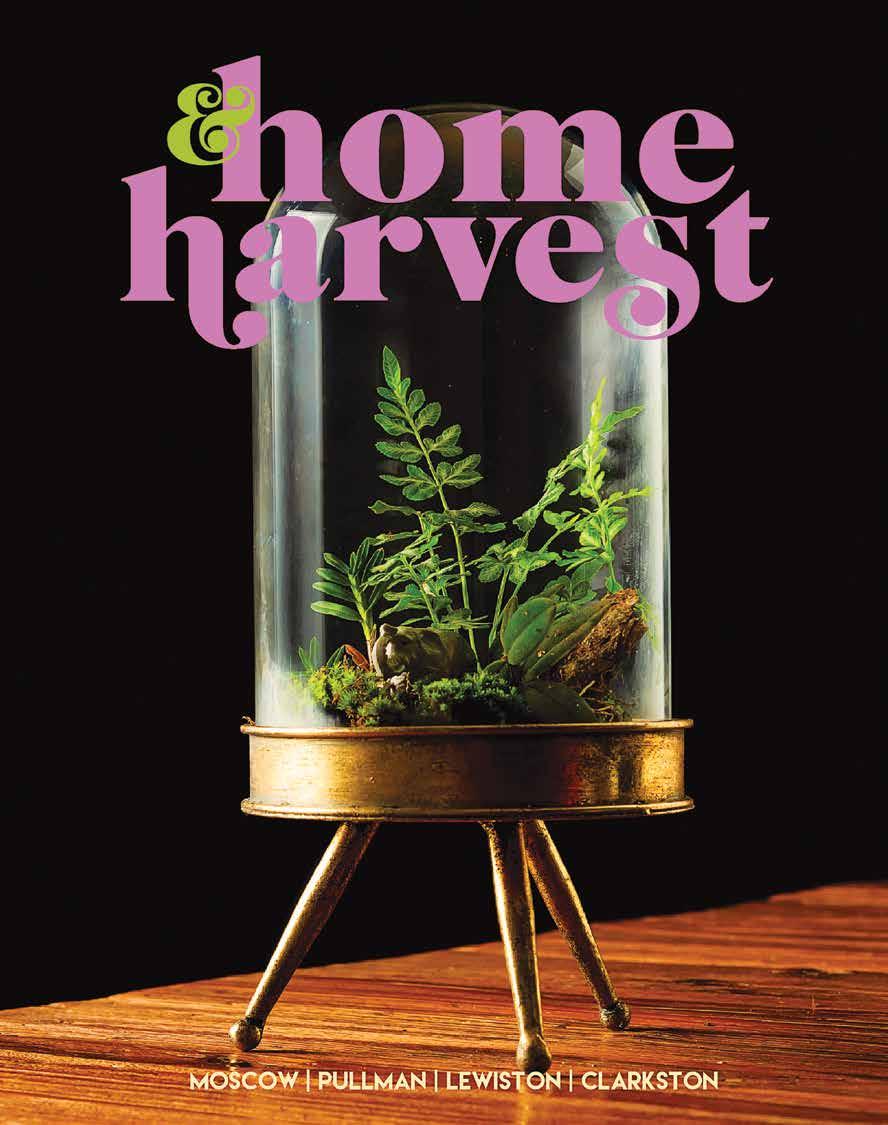







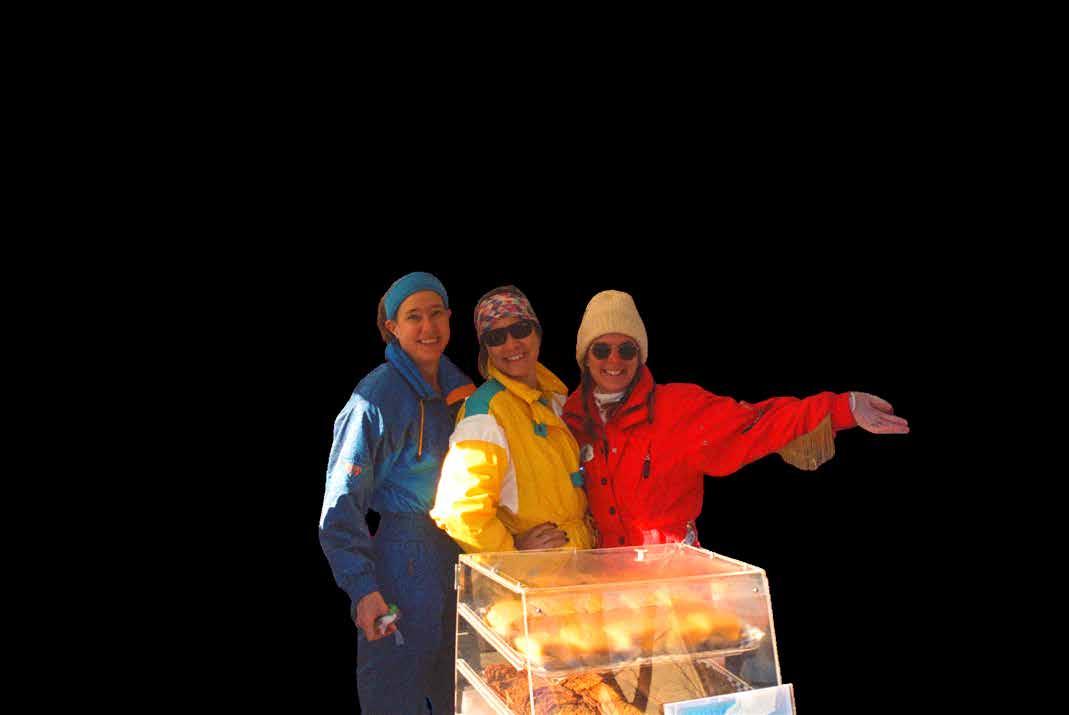








LY KI Y N WN W, TODAY
E B 4TH 2023 B O O K Y O U R S T A Y
F

I wanted to dedicate this issue to something we all need: hope.

When I saw this cover idea, it sparked something in me that made me weep. Truth is I’ve been feeling so much self-doubt, fear and grief lately. I have been having so much trouble being vulnerable and creative, especially since being stuck in fight-or-flight from caring for and then losing my mom. These last few years haven’t hardened me, but they have taught me one very important thing:
Let hope grow.
How often do you talk yourself out of a dream, a goal, or even stepping into the shoes of who you are supposed to be? I know I do all the time. I’ve blamed my anxiety on this, and the truth is it’s not fair to use that excuse. Sometimes it just takes a little hope to realize that you can rise out of a situation, become who you want to be, and find inner peace and happiness. Lately I’ve been reasoning there are so many negative things happening in our world. But so much could be said about the incredible things as well! Why not focus on this, and grow it even bigger?
I’ve always felt that winter was an incubation period. Fall was a time for letting go, but winter is when you grow the seeds of life. I know it’s difficult to encourage yourself when you are feeling fear, or the blahs, or even depressed! That’s why I’m encouraging you. It’s time. Maybe you’re not ready to take the leap yet but that’s why hope needs to show up and be given a chance. Don’t talk yourself out of something without remembering the power of hope!
This year, I am remembering how to live again- even though, even when, and especially the days I feel too tired to show up. It’s the little things for me that matter the most. I am also growing the hope of being vulnerable, opening my heart, and feeling childlike wonder about possibility. So far I’ve begun to sing again, dance again- visioning my mom and me twirling around in the kitchen- even if I did trip over my open dishwasher, haha! I’ve signed Tony and I up for classes. I went to lunch with a friend and scheduled another! We started trapshooting again. I told Tony, it’s time we are tired from fun and not work! We love our businesses but there’s nothing that restores your soul more than feeling carefree and enjoying a variety of passions and new ventures as well!
Let this cute little budding fern on the cover remind you that it doesn’t matter how small the seeds are- you are worth believing in and you can grow the hope you need to live the life you dream of! I hope this year finds you happy, healing and hopeful. You deserve it!
Home&Harvest Magazine kk


Grow, Gratitude, Grow 8 Too Many Valentines 12 Heidi's Book Review 18 Going Dutch 20 Hungarian Mushroom Soup 24 Strawberry Cake 26 Apple + Blue Cheese Bread Pudding 28 Lemon Bread 30 Nutter Butter Cheesecake 32 Perfected Egg + Dairy Free Bagels 34 Cooking For Connection 36 Global KO2M Championship 42 A Reading For You 50 Great Grapes 52 People of the Palouse 58 Drifting with the South Wind 66 The Oh, Otis Shenanigans 76
Grow, Gratitude,
 by Annie Gebel
by Annie Gebel
Gratitude, Grow
I love music. There’s literally a song for any mood, feeling, emotion, life situation. And, this one I find myself in right now is no exception. As I sat here at my computer, watching that blinking cursor, trying to come up with some profound message for you for Valentine’s Day - I struggled. This last year or two were more about the dissolution of everything I thought I knew and learning who I was all over again than they were about hearts and roses and boxes of chocolate. Even with a plethora of love songs to choose from, I wasn’t feeling inspired. So, what could I possibly say to inspire you?
Then I remembered this little song that I adore. It was released before I was born by a singer/songwriter named Tom T. Hall and it’s simply called, “I Love.” Here are the lyrics:
I love little baby ducks, old pick-up trucks, slow-movin’ trains, and rain. I love little country streams, sleep without dreams, Sunday school in May, and hay. And I love you too.
I love leaves in the wind, pictures of my friends, birds in the world, and squirrels. I love coffee in a cup, little fuzzy pups, Bourbon in a glass, and grass. And I love you too.
I love honest open smiles, kisses from a child, tomatoes on the vine, and onions. I love winners when they cry, losers when they try, music when it’s good, and life. And I love you too.
It’s such a sweet, simple reminder of what love can be about. It can be about chocolates and flowers (and I absolutely enjoy those things!) and it can also be about the things we’re thankful for in life.

When I was in college I had this book that was called 10,000 Things to be Happy About, by Barbara Ann Kipfer. (I just looked it up - she’s added 4,000 more things to the list!) When I was bored or lonely or sad I’d flip open to a page and read a few things from the massive list. And that’s what Tom T. Hall’s song makes me think of…things to be happy about. Things he loves. I can get on board with that. Even if my heart may not be ready for ooey-gooey, eye-rolling, heart-fluttering partnered love at the moment, there are many things I’m happy about.
So, if you’re in a place like me, where you’re less likely to hit up the pre-sales on Valentine’s goodies and more likely to over-indulge on the after-clearance, let’s let our gratitude grow! Even if you have a love to share the day with, a little gratitude probably won’t hurt you either!
How do I propose we grow gratitude? Well, to start with, we can add another verse or two to the song (wait for it, mine is coming!) or come up with our own list of things to be happy about (I have a journal that I started several years ago and add to from time to time). How long would it take you to beat Ms. Kipfer’s 14,000 things?! (I’ve barely reached 100!)
We could also start each morning with three things we’re thankful for before we even get out of bed. We could mentally note something at the end of every day that we’re grateful for. We could write thank you notes, and not just in response to getting presents (although, that’s a great thing to do, too) but also to your favorite teacher, mentor, childhood friend. You don’t have to be thankful for only recent activities. I have definitely written to teachers decades after graduation. Sometimes a memory hits you and you wish you’d recognized it for the beautiful seed it was in your life then, but you couldn’t have until it truly took root and blossomed. So, when you do see how influential that person was - why not tell them? You could also thank people who are actively in your current life by writing notes to your landlord, the kids’ bus driver, your mail delivery person, the person who changes your oil, the editors of your favorite magazine. Who doesn’t love an unexpected thank you? Spread some love and watch your gratitude grow!


Perhaps writing isn’t your thing, but you really enjoy bringing people together. Maybe you could gather a group of friends or family and enjoy a hot chocolate bar while encouraging each other’s passions. Or start a gratitude club where you get together and have a person or two share a story about something they are grateful for - like public speaking practice and finding joy! Love it! Maybe you put a blank sheet of paper on the counter by the hors d’oeuvres and let people jot down things they’re thankful for throughout the night. Heck you could even do something like that in the workplace. Imagine a list of gratitude on the wall in the teacher’s lounge, at the nurses’ station, or posted next to the time clock. Sure maybe people would scoff or be funny, but maybe they’d also enjoy a little more gratitude in their lives too. Need more ideas? What if you went on a gratitude scavenger hunt? You could play the game with your kids, your friends, or on your own. Make a list of things you’d feel most grateful to see and then see how many you can find in an afternoon, a day, or a week! Here’s an example list:
Something cute
Someone helping someone else
A splash of unexpected color
Art
Children laughing
Pizza
Let’s be honest, the list could contain anything! Let your happy imagination run wild!


Another way to play with the idea of love and gratitude is to share them with someone else - maybe even your Valentine! You could do so simply by sending a text or snap or posting about the things you find that bring you joy. You could raise the bar by sending actual mail containing some of the things you’re grateful for. You could even start a shared scrapbook that you and others add to, pass around, really enjoy the memories of - all about the things you love! Do you think you could get to thousands like the book of things to be happy about?
If texting or scrapbooking or grateful social gatherings aren’t your thing, maybe you could create a playlist of music that declares what you love. Or, better yet, write your own song. Here’s mine (sung to the same tune as Tom T. Hall’s - why mess with a good thing?):
I love hearing water flow, petting cozy cats, getting a warm hug, and mugs.
I love feeling quite content, playing games with friends, hearing my teens laugh, and punch. And I love food too.
I love wrapping in a blanket, coffee on the porch, a knocker on a door, and lore.
I love reading to a child, whistling a tune, wrapping and unwrapping, and myths.
And I love truth too.
I love walking in the woods, sitting in the tub, mirrors with gold frames, and rocks.
I love flowers in the spring, resting anytime, hillsides covered in fog, and me!
And I love you too.
Okay, okay…I won’t quit my day job. Luckily, I also love that.

T
Too much of everything. This is what we have here at White Spring Ranch, Genesee. Of course, that’s half the fun of it.
Someday this will be a proper library with everything cross-referenced, but for now we just get to enjoy the overabundance. So many seriously interested family members saved so many mementos that the archeological collection defies imagination.
Yes, we really do have almost 5,000 letters dating from 1877, without missing hardly any years at all. We really have 1,000 different magazine titles. That’s not counting the numbers of each title. Movie Life, Saturday Evening Post, Life Magazine, Farm Journal, Seventeen, Hunting & Fishing, Furrow, Screenland, Sunset, Radio News, Collier’s…the list is quite long.
And the Valentines from 1900 to 1960 are an interesting collection in themselves. Just by looking at these you can learn quite a lot about life in America in the 20th century. In 1900, it was all about lace and decoration. This gradually became cards that were more casual, sweet and funny. The 1940’s were all about practicality and getting by during WWII. In the 1950’s and 1960’s the decorations were streamlined and became more mass produced. But they all tell a small bit of story of their times. In this article there are a few samples of the hundreds we found here at the Ranch.
I also wanted to include some of the best Valentine original letters that have been found. The first is from 1880 and 1883 when homesteaders John and Mary Lorang (then Gesellchen) were courting. This was a few years before they married and moved West in 1884.
Written from Mary Gesellchen to John Lorang in 1880; the letter preserved until this day:
“Today the 6 of Sept. Oh Dear John, Finally I leave everything behind and am writing to you. Dear John, you wrote that you would come in two months. This makes me real happy and my brother-in-law and sisters too. The kids fondly talk about you a lot. Yes my Dear John I am so glad that you are coming home, I mean I am lonely and I don’t care about nobody else in all of Calvary. (a small town in N. W. Wisconsin) Oh Dear John you write that I should forget what you wrote in the letter before the last one. That is all right Dear John because you were right… Dear John the carpenters are building a big college here. The walls are already quite tall. Thomas told me he is going there this fall. Oh Dear John last week I spent three days at my Brother-in laws and he told me that he shared some great fish with you. Then you were able to fry you some fish. Oh Dear John I don’t know any news. Oh my are the two months so long. The moon is light The stars are bright And so is my heart for you. Friendly Greetings from my Parents and Siblings and especially from me. Your true so loving Mary Anna Gesell. Mary Gesellchen
Say, can You think my love is chill
Nor filled on you alone!
And can you rend by doubting still A heart that’s all your own!


My love thou canst know not.
No one can ever know
O! say must that be love.
My joy, or my woe?
Please excuse my bad writing as I have a bad pen. Answer me soon as it is going to be two long months. Now I have get back to work as I still have lots of work to do.”

This one was written by John Lorang to Mary Gesellchen in 1883. We still have this letter.
“Today the 18th day of March, 1883
Oh, my dear Mary, I feel like it is time for me to again write a few lines to you. It is already over a month since I answered your last letter and I have not had an answer from you.
The time is very long for me as every time the mail comes I wait for a letter from you and there is never one. I thought that this time there would be a letter from my Mary but still no letter.
Oh, dear Mary I am very restless as I can’t figure why you do not write. I have all kinds of thoughts but I can’t think they are true until I hear from you. I wonder if I hurt you in some way that you did not want to write to me. Or did you find someone else that you like better than me. If any of these things are true please let me know. If you get my letter on Wednesday the 21st of March then write me again the same day so I can receive it before we move. We are staying the week but how much longer no one knows. Perhaps we will go down right away but it could that we are still here the First of April. If you cannot answer my letter right away then send it to Wausau. So I will have a letter from you when I come out of the bush. Perhaps I will stay 1 or 2 months in Wausau. If I get good wages then I will want to come home.
Dear Mary, don’t feel bad about my letter I am having a bad day. I had to write it the way I was feeling. It is about time for me to get out of the woods as I am sick and tired of it.
Now I will close and send loving greetings to you from your unforgettable John Lorang

(In English)
Write soon and forget me not.
This next letter was written the same day as above, when Mary wrote to John in 1883 and the original is in our letter collection.
“Fond du Lac, March 18, 1883
I finally have to take time to write to you. You have no idea why I haven’t written to you sooner. The time has gone so fast. The wife of the people where I board is very sick and the baby is also sick. Whenever I come home from work I have to hold this child because it always cries for me.
Sundays I go to church and when I get home I have to cook dinner and the rest of the afternoon I have to hold that child. Today I told the husband he has to hold the child so I could write to you.
Yes, my dear John we have to work very hard in this world. I wash everyday very hard and then when I home then I hold the child from 7-10 and sometimes 12. Except last Wednesday I stayed up until 2 a.m. in the morning and then I had to get up at 6 a.m. and went washing until 6 in the evening.
Yes, Yes, I must endure it and I can’t say anything because she is very sick.
Yes my dear John, it is real stormy and it is snowing. I don’t know anymore and I am still healthy. I will close with thousands of greetings to you from your loving Mary Gesellchen.
A kiss for you from your true love Mary G.


This next letter we have was found in the Curio cabin and was written by Henry Lorang, son of John and Mary.
In 1919, Henry Lorang is building the Bungalow home, just S.E of the barn for his new bride Marguerite Tobin Lorang.
“In Our Own Dear Home
December 14, 1919
My Sweetheart Wife:
Sorry I kept you waiting-- dad had me write a letter to a friend in England to deliver a letter for him to an egg collector, so I am just two hours later than I expected to be.
Can you see me? I am sitting on the little old chair, by the heater, in the kitchen with my tablet on my knee for a writing desk-escritoire.

When I sit and listen to the clock tick, it seems very lonely in this house all by myself. When I am at work, it is alright for then I make some noise to counteract the tick-tock monotony of our new clock.
Yes I get awfully lonesome at times and dearest, you want me to, don’t you? For if I did not I would not miss you much. Never mind me though, Marguerite, I know you are lonesome too – anyway I want you to be – and it will not be long before all will be in readiness here to receive you and you will be ready to help put on the finishing touches to make it inhabitable just for weuns.
(Monday) Oh! Sweetheart, you had ought to see the lonely presents you are getting from all directions.
Uncle Tom sent a clock, Rudolph sent some kind of pretty dish with a silver handle on it, brother Pete sent you six of the prettiest salad forks that you ever could dream of. This morning there came in the mail a beautiful hand-worked dresser runner from our friend Lena Schwenne. I will write and acknowledge the gifts all except Lena’s –you may see her.
Your loving letter came this morning and I’ll say you surely are a thoughtful dear with your suggestions. Don’t worry sweetheart I am all O.K. and doing nicely even if I am sick with lonesomeness. After my pen went dry last evening I tried to read but that didn’t satisfy so I got our old pal water bottle and “rolled in”. Then I was more lonesome but I finally went to sleep and awake quite refreshed to go to work.
I am coming down as soon as I possibly can, believe me, darling. Lots of Love to everybody from your loving husband, Henry”
There are more stories, endless stories with firsthand documentation.
If you would like to see this, stop by on Sundays and Tuesday 1:00 pm to Sunset or anytime by appointment. You are very welcome.

Valentines from the Lorang collection

by
heidi pederson
Hannah Hall is living an idyllic life in a house boat married to her husband Owen Michaels. She is working on trying to build a relationship with his teenage daughter Bailey. Bailey lost her mother tragically as a child and wants absolutely nothing to do with her new stepmother.
Then one day Owen disappears. Before he does he manages to get a note to his wife that says one thing: Protect her. Hannah knows that means she must protect Bailey. As Hannah’s calls to Owen go unanswered, the FBI arrests Owen’s boss, the US Marshal and FBI agents arrive at Hannah’s house unannounced and she quickly realizes her husband isn’t who she thought he was and Bailey just may hold the key to figuring out his true identity and why he really disappeared. Hannah and Bailey must work together to piece together Owen’s past. While doing so they start to build a new future together neither of them saw coming.
I love a good mystery and this one won Goodreads Choice Aware for Mystery & Thriller (2021). This book starts off fast paced and keeps going. With short chapters and great character development it will leave the reader guessing until the very end. This story is told from Hannah’s view point but also involves a great deal of character memory on Bailey’s part. You will explore parts of her and Owen’s past that make you second guess what happened in the present day.
While reading this book you will experience Hannah’s emotions with her. She never feels sorry for herself but her emotions are subtle and real. She is worried for her husband and her relationship with Bailey. This book is very character driven. The plot is a good start but from there the characters and their stories and emotions drive the book, leaving the reader both intrigued to know what comes next and wondering how the characters will go on. This book may start out about the relationship between Hannah and Owen it becomes about Bailey and Hannah. As a mother I couldn’t help but root for them to become friends and build a mother/daughter relationship.
I rated this 5 books out of 5 books. This book is being made into a mini-series for TV and I am super excited to see if the series lives up to the book. Do yourself a favor and read the book before you watch the series, you know- just in case they leave things out. If you are looking for a great fastpaced, hook-you-from-the-beginning mystery, this is it. I have a few friends who have read it and loved it too, so that is why I decided this was my selection this time around. We all can’t stop talking about it. Hope you enjoy it as much as we all did. Until next time fellow readers. Happy Reading!
Dave
The Last Thing He Told Me by Laura
Home&Harvest | Jan/Feb 2023 18
book HEIDI’S REVIEW


Flank Flame to

Going Dutch
by Tony Niccoli
I do a lot of grilling. And smoking. And cooking directly over campfires. Its sort of my happy place. But one thing that I hadn’t ever really gotten into was true art of Dutch Oven cooking. I’d kept it high on my list, and mused about getting started many times, but never really took the plunge into this exciting (new to me) form of cooking over flame.
So, on my birthday this year, as the November December issue was just about to come out, the weather was quickly cooling, and I was writing my 50th article in this series, I had a huge burst of anticipation as Heather dropped a ridiculously heavy present on my lap. Could it be? Too heavy to be socks! This thing weighed about as much as a bowling ball. Could it be? Too small to be a set of dumbbells. It had to be!
I tore off the wrapping paper and gasped – not only had she gotten me an absolutely amazing Dutch Oven, but I could tell with just a glance that it was vintage. I was holding in my now slightly crushed lap, a full size, nearly 100-year-old, perfectly restored and seasoned cast iron cook pot. I was about to join a long line of chefs, going back throughout the ages who cooked in iron ovens directly on flame. What a perfect gift!
So here, as I start the 2023 run of Flank to Flame, in our 9th year of printing the magazine, I want to do a full year of the series dedicated to Dutch Oven cooking. We will be taking a look at some of the history of these fascinating cooking devices, and the centuries-old techniques that brought them into the home when the hearth fire long predated any type of oven or stove. We will take one out camping to elevate our wilderness cooking, and use them in several ways on the grill at home. If you already cook, broil, bake, and grill with a Dutch Oven I hope you pick up at least a few new recipes, and have your enthusiasm renewed. And if you are new, or have always wanted to jump in like I did, I hope this gives you that final push. Find your own refurbished classic, or just grab a brand new one. Get it seasoned and ready, and bring along your appetite. It’s time to light that fire and get to cooking.
So, for our first foray into the world of Dutch Oven cooking, I’m going to start you off with an easy one that can be done completely inside if you still haven’t cleared all that snow off of the top of your grill. Or, if you want to be a bit more adventurous and follow me outside where I have the coals all burning and already ashed-over, we can do this cook together over open flame as it would have originally been done. And if you still haven’t gotten your hands on that coveted Dutch Oven, this should be something you can pull off relatively well with a normal pan and casserole dish. Just know that if you do go that route, the depth of flavor will definitely not reach what is possible on a well-seasoned cast iron surface.
Along with the Dutch Oven, Heather got me a cook book. It had some amazing recipes, but many seemed just a little over my head for a first pass. I’ve worked with cast iron on grills and campfires before, but not knowing all the thermal properties of this new tool yet, and not wanting to risk burning or ruining something on my first attempt I decided to take one of the most basic suggestions they had and changed it a little to make it my own.

This comes with a fancy-sounding French name –Tartiflette– but it’s a pretty approachable flavor profile. With cold days just starting to get their grip on us when I first tried it, and no doubt still firmly in control of our weather as you read this, a hearty, winter stew of potatoes, bacon, onions, garlic, and rich and creamy cheese is that perfect way to end a day and gather your family around the dinner table. Consider treating everyone to this after a great day of sledding, or ice skating. It really warms you and takes the chill out of the air.
Start with about a pound and a half of medium potatoes. Rinse and peel them and cut any of the larger ones in half to speed up the cook. Go ahead and toss them into the Dutch Oven and completely cover with water. Here the adventurous cooks can walk out and brave the snow to do this pioneer style over a bed of coals, or pilgrim style over a nearly coaled log. For anyone who wants to avoid the chill of winter air, just set it on your burner inside. I won’t tell!
Bring it to a full boil and the cook for 10 minutes with the lid on –the potatoes should be nearly cooked but still just a little firm. Go ahead and dump that hot water, and run the potatoes under cold water to stop the cooking for now. Once cool, cut them into large, but edible chunks, maybe about an inch or a little less. Rinse and wipe out that Dutch Oven so its ready for the next step.
Put two table spoons of oil in there along with 5 strips of thick cut bacon that has been cut into diced cubes. Go back onto the coals or burner for about five minutes until that bacon starts brown. Add one thinly sliced red onion, two cloves of crushed garlic, and plenty of salt. Keep this cooking for another five minutes (a little longer if outside in the cold) until it all starts to soften up and caramelize. You’ll know by that amazing smell when its time to move to the next step.
Once that pot is well on its way to rendering together in a perfect balance of flavor we want to put the potatoes back in along with 1 cup of unflavored full-fat Greek yogurt or the more traditional option of crème fraiche if you prefer. Stir it well and add ½ teaspoon of black pepper. Put that lid back on and cook for another minute to let it all meld. Then remove the lid and top it with one pound of shredded cheese. If you want to be as traditional as possible to the French classic use something like Gruyere, Fontina, Reblochon, or Raclette. But the recipe I read said that you could use a mix of any hard cheese and Mozzarella, so I decided to cut the cost a little, and make ours a bit more like flavors I’m used to buy going with ½ lb. of fresh Mozzarella and ½ lb. of Gruyere. I liked the idea that this would add a little familial balance to the crusty loaf of Italian bread that I had picked up to act as a back-up spoon for this wonderful stew.
With the cheese spread over the top (in a single layer if your Dutch Oven is large enough, or by removing some of the potato, onion, and garlic mix first and creating a base layer that is coved evenly with cheese, and then a second top layer that also has a cheese cap) put the lid back on a move to the oven if inside, or cover the top with fresh coals if you are out on the grill. This needs to cook at 400 degrees for about 28 minutes. It should be bubbly, browned at the edges, a little crusty, and golden along the top when finished.
I still don’t know how to pronounce it, but this is quickly becoming one of our favorite things to eat this winter. Serve with a glass of red wine, and a simple salad with some balsamic vinegar and oil over mixed greens for one amazing way to forget the cold outside!


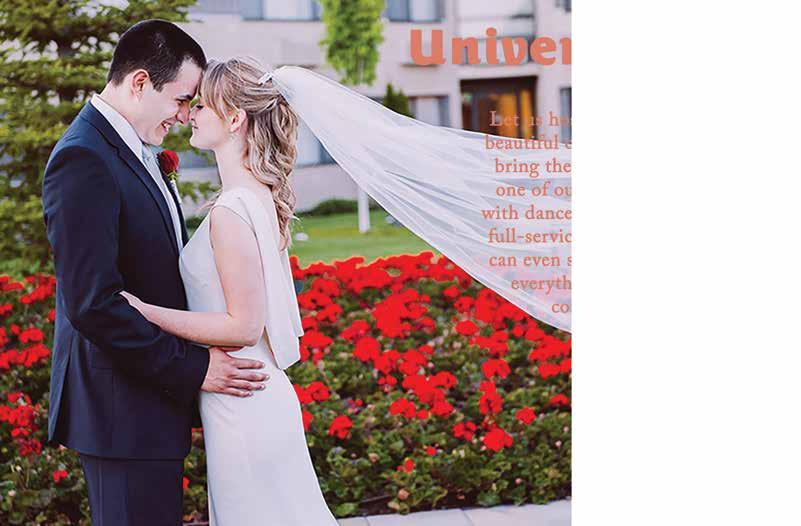


HUNGARIAN
vegetarian mushroom soup

KITCHEN
INGREDIENTS
6 Tbl butter
2 cups onions, chopped
heather niccoli
1 lb mushrooms, sliced (I recommend white, shitake and porcini)
2 cups vegetable stock
1/2 cup dry white wine
2 tsp dill
3 tsp minced fresh thyme leaves
2 tsp paprika
2 Tbl soy sauce
1 cup heavy cream
3 Tbl flour
1/4 cup sour cream
3 Tbl lemon juice
fresh Italian parsley to garnish
STEPS
Cook the onions and mushrooms in butter until onions are translucent- careful not to overbrown! Stir in the dill, thyme, paprika, vegetable stock, soy sauce and white wine. Bring the heat up to a simmer until the liquid reduces about half. In a separate bowl, combine cream and flour with a whisk. Add it to the heat until everything thickens. Let the soup simmer on low and gently fold in the sour cream and lemon. Garnish with mushrooms or parsley. Serve with crostini croutons and a kiss!

INGREDIENTS
Cake
3 cups of quartered strawberries*
3/4 cup sour cream room temperature
1/4 cup milk room temperature
4 large eggs room temperature
1 tsp vanilla extract
2 1/2 cups all purpose flour
1 1/2 cups sugar
2 tsp baking powder
1/2 tsp baking soda
1/2 tsp salt
3/4 cup unsalted butter, room temperature
7–9 drops pink food color, optional
Strawberry Cream Cheese Frosting
¾ cup freeze dried strawberry powder
16 oz cream cheese, room temperature
3/4 cup unsalted butter, room temperature
10 cups powdered sugar
1 tsp vanilla extract
Pinch of salt
3/4 cup chopped strawberries
STEPS
cake with strawberry cream cheese frosting
sara raquet
1. To make the strawberry reduction, add the strawberries to a food processor or blender and puree until smooth. You should have about 1 1/2 cups of puree.
2. Add the puree to a medium sized saucepan and cook over medium heat. Allow the mixture to come to a slow boil, stirring consistently to keep it from burning, until it has thickened and reduced to 3/4 cup, about 20-25 minutes. To measure, pour the puree into a measuring cup. If it’s more than 3/4 cup, add it back to the pan and continue cooking.
3. When the puree has thickened and reduced, pour into a large measuring cup and allow to cool to at least room temperature. This strawberry mixture can be made ahead, if you like, and stored in the fridge.
4. Preheat oven to 350°F and prepare three 8-inch cake pans with parchment paper in the bottom and baking spray on the sides.
5. Combine the strawberry reduction, sour cream, milk, eggs and vanilla extract in a large bowl, then separate about 1 cup of the mixture into another bowl or measuring cup. About 1 1/2 cups should remain in the other bowl. Set both aside.
6. In a large mixer bowl, combine the flour, sugar, baking powder, baking soda and salt.
7. With the mixer on the lowest speed, add the butter about a tablespoon at a time, allowing it to incorporate before adding the next tablespoon. As you add more butter, the mixture will start to clump together a bit a should end up resembling wet sand.
8. Add the larger of the reserved egg mixture (about 1 1/2 cups) to the dry ingredients/butter mixture. Stir on the lowest speed until it’s incorporated, then scrape down the sides of the bowl.
9. Increase the speed to medium high and beat until light and fluffy, about 45 seconds to one minute. Scrape down the sides of the bowl.
10. Turn the speed down to low and slowly add the remaining egg mixture in a slow stream until incorporated.
11. Scrape the sides of the bowl, then turn speed back up to medium high and mix until well combined, about 10-15 seconds.
13. Divide the batter evenly between the three cake pans and bake 24-26 minutes or until a toothpick inserted comes out with a few crumbs.
14. Remove cakes from the oven and allow to cool for 2-3 minutes, then remove to cooling rack to cool completely.
15. In a large mixer bowl, beat the cream cheese and butter together until smooth.
16. Slowly add half of the powdered sugar and the vanilla extract and mix until smooth.
17. Slowly add remaining powdered sugar and strawberry powder and mix until smooth. Add some salt, to taste. Set aside.
18. Add about 1 cup of frosting to the top of the cake layer and spread evenly. Add about half of the chopped strawberries and press into the frosting.
19. Add the second layer of cake, another cup of frosting and the remaining chopped strawberries.
20. Top the cake with the remaining layer and frost the cake with the remaining frosting. Pipe decorative frosting as desired.
strawberry kitchen
Home&Harvest | Jan/Feb 2023 27

Apple & Blue Cheese bread pudding
KITCHEN emory ann kurysh
This is a modified recipe from an old Kinfolk Magazine article that I rediscovered recently. It was geared toward single servings- not for large families but more so just for the reader to indulge in. Below is what was written:
“Depending on your level of carb-indulgence, it can be difficult to polish off a whole loaf of bread solo before it gets stale. This recipe offers a clever way to use those chewy end bits before they go bad, fusing them with something you’re meant to let grow pungent.” -Kinfolk,
v. 11, p. 35
The main difference is that I removed the eggs and honey from the original recipe, added some vanilla, and changed the measurements. It turned out so lovely- especially if you are a lover of sweet and salty.
INGREDIENTS
1 tbsp butter
1 cup bread, torn into pieces
1/2 cup milk
1/4 cup granulated sugar
Pinch of salt
1 apple, peeled and diced
1/2 tsp vanilla extract
2 tbsp blue cheese, crumbled
STEPS
1. Preheat oven to 400°F. Coat an oven-safe ramekin with butter.
2. Add the bread, milk, sugar, salt, apples, vanilla, and blue cheese to a bowl. Gently mix until everything is coated. Then pour into the ramekin. Place in oven and bake uncovered for 30 minutes. Remove and serve warm.
Home&Harvest | Jan/Feb 2023 29
LEMON BREAD LEMON BREAD LEMON BREAD

kitchen sara raquet
INGREDIENTS
1/2 cup butter, softened
1 cup sugar
2 large eggs, room temperature
1 tablespoon grated lemon zest
2 tablespoons lemon juice
1-1/2 cups all-purpose flour
1 teaspoon baking powder
1/8 teaspoon salt
1/2 cup buttermilk, room temperature
Glaze
1/2 cup confectioner's sugar
2 tablespoons lemon juice
STEPS
Preheat oven to 350°. In a large bowl, cream butter and sugar until light and fluffy, 5-7 minutes. Beat in eggs, lemon zest and juice. Combine flour, baking powder and salt; gradually stir into creamed mixture alternately with buttermilk, beating well after each addition.
Pour into a greased 8x4-inch loaf pan. Bake until a toothpick inserted in the center comes out clean, 40-45 minutes. Cool in pan 15 minutes before removing to a wire rack. Combine glaze ingredients; immediately drizzle over bread.

Home&Harvest | Jan/Feb 2023 31

nutter butter
INGREDIENTS
Nutter Butter Crust
3 cups Nutter Butters, finely crushed
5 Tbl butter, melted
Chocolate topping (optional)
2 cups heavy cream
12 oz semi sweet chocolate chips
Peanut Butter Cheesecake
3 packages cream cheese, room temperature
½ cup sugar
1¼ cups creamy peanut butter
1 teaspoon vanilla
¼ cup sour cream
1¼ cups heavy cream, cold
¾ cup confectioners’ sugar
STEPS
Nutter Butter Crust
Mix cookies and butter until well combined. Spread in a spring form pan and set aside.
Cheesecake Filling
Cream together the cream cheese and sugar until smooth. Add the peanut butter and vanilla and blend until smooth. Slowly fold in the sour cream. Set aside.
In a separate bowl mix your heavy cream at the lowest speed until it becomes fluffy whipped cream. Slowly add in the confectioner’s sugar and mix until stiff peaks form. Fold this mixture into the peanut butter filling. Pour into the cookie crust and refrigerate! When cheesecake is cold, make the ganache topping. Heat cream just to a boil. Pour the cream over the chocolate in a separate bowl. Let sit for a few minutes and stir smooth. Pour over cooled cheesecake and chill overnight (if you can wait that long!)
KITCHEN
cheesecake
heather niccoli
Home&Harvest | Jan/Feb 2023 33
PERFECTED
Egg and Dairy-Free Fluffy Bagels KITCHEN
I made and submitted a recipe for bagels a few years ago that I have since made dozens of times since. I have changed the recipe enough that I felt like it warranted a new submission. These bagels are so big and fluffy and my own family actually request that I make them more often than I make bread and buns. Try them (again) for yourself!
INGREDIENTS
1/2 cup granulated sugar
1 1/2 tbsp active dry yeast
2 cups warm water
1/3 cup canola or vegetable oil, plus more to grease
1/2 tsp salt
6 cups all-purpose flour
STEPS
emory ann kurysh
1. Add the sugar, yeast, and warm water to a large bowl. Mix well, then cover with a tea towel for 15 minutes or until the yeast has bubbled.
2. Remove towel. Next add the oil, salt, and flour. Make sure to stir between each cup of flour. When the dough is no longer sticky, transfer to a floured surface. Knead for another 5 minutes until smoothed out. Form into a large ball and place in a new, large, oil-greased bowl. Cover with a tea towel. Put in oven with the light on for 1 hour to let rise.
3. After dough has risen, remove it from oven and punch it down. Then transfer again to a smooth surface. Separate into 12 balls. Poke your thumb through each ball and form into the shape of a bagel. Place onto a lightly greased cookie sheet. You may need two. Cover with a tea towel and let rise for 30 more minutes.
4. Meanwhile preheat oven to 375°F. Bake for 30 minutes or until a deep golden brown. Remove and brush with butter or margarine (regular or dairy-free). Let cool down before slicing into them. Enjoy! Note: You may choose to add something to the top of the bagels, such as poppyseed. If so, do so right before placing them in the oven. Store in an airtight container at room temperature for up to 3 days.
Home&Harvest | Jan/Feb 2023 34
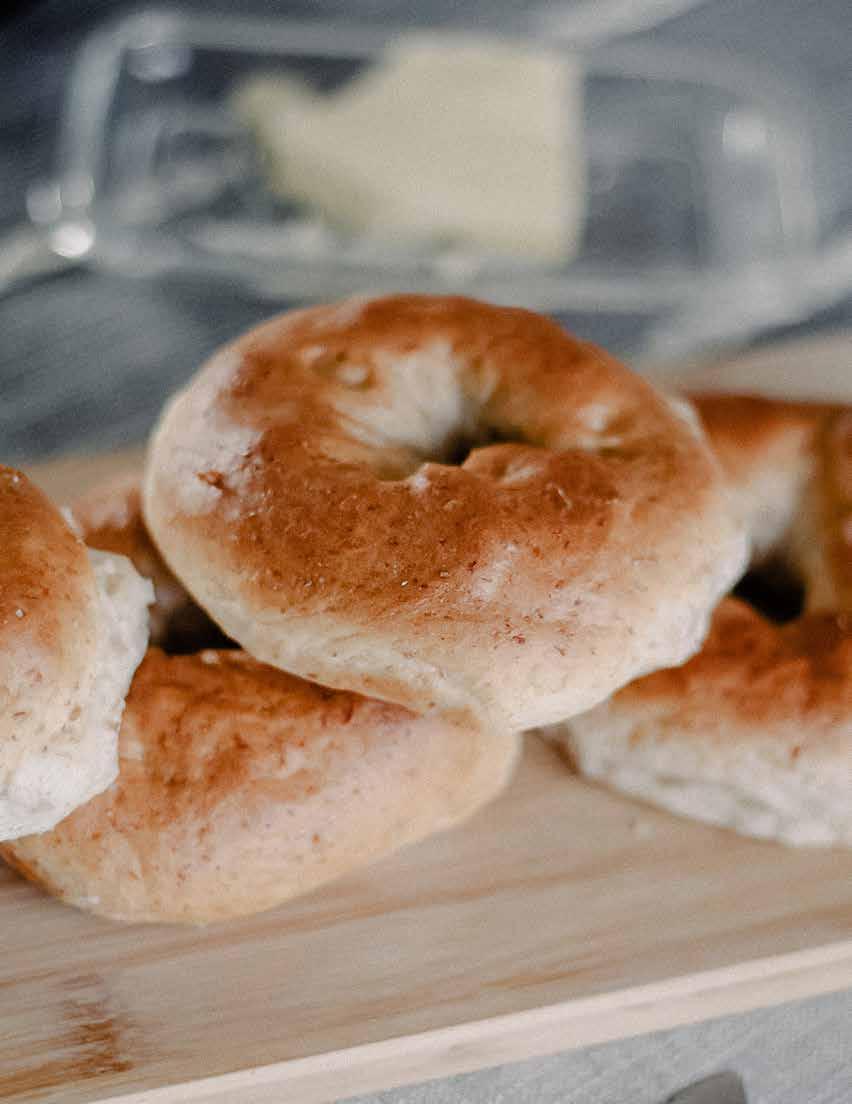

Cooking for Connection by Hayley Noble
‘Tis the time of year when we at LCHS discuss historical sources and the many ways historians use those sources. We’ve written about letters, the census, oral histories, journals, and many more – now it’s time to examine cookbooks and recipes as historical documents.
Food has long been a central part of heritage and cultural practices, and it remains that way for many people. Mealtime gatherings are staples in our holidays and traditions: 4th of July barbecues, Thanksgiving dinner, and Christmas feasts to name a few. If we are lucky, many of those times include family and friends, and feature our favorite recipes. For some, those recipes could be passed down or serve as a reminder of relatives and where we come from. I’m sure I’m not the only one with fond memories of baking cookies with my grandmother, using her favorite recipe that I still reach for today. It helps me feel closer to her since she’s passed and reminds me of a different time. My family still brings out a 1950s Jell-o, cream cheese, marshmallow “salad” that was a treasured piece of my dad’s holidays growing up. While these cookie and “salad” recipes are not indicative of my cultural past, for many, passed down recipes are a way to honor their roots and remember relatives. Now I feel I should also differentiate between cookbooks, community compilations, and family recipes. Cookbooks are those that are widely published and not necessarily regionally specific. Their contents can reflect historical events and national trends, but do not generally represent individual communities. Most of this article is in reference to family recipes and community compilations. All have their uses, but the latter two are the primary focus. My use of the word “cookbook” can mean both community compilations and widely published volumes. Beloved recipes when compiled into cookbooks become valuable primary source historical documents. They can inform about national trends, materials available, and current technologies. Speaking of Jell-o once again – it rose to prominence in the 1930s as the country was gripped by the Great Depression. Cheap and needing few ingredients, Jell-o made meals easier and provided a way to stretch food to help families struggling to make ends meet. Those children growing up in the Depression are the ones creating these Jell-o salads so typical of the 1950s. The 1940s saw the rise of Spam with a nation focused on wartime production and rationing. Meat was difficult to ship and store. Spam provided an alternative that was mass-produced and canned, did not need refrigeration, and was cheap to buy. Both the military and housewives saw the potential that Spam could be. Cookbooks from World War II included Spam, but also other ways to substitute meat and accounted for rationed ingredients like sugar and butter. More information on rationing can be found in the March/April 2021 edition of Home&Harvest Magazine.
Currently, American food trends are flooded with dietary restrictions. Some folks are vegetarian or vegan for animal welfare causes or green reasons, while many practice restrictive diets due to food allergies, such as lactose intolerance or celiac disease, among others. We cannot predict what future researchers will conclude about our era of food-
-history, but what cannot be ignored are the ingenuity and science behind food. In the past, if you felt sick after eating something, you just did not eat it again. Now lactose intolerance is an inconvenience, but just about everyone can still enjoy a latte with a milk substitute, or ice cream with short-lived medication. Gluten-free menu items are gaining popularity and meat substitutes abound to accommodate these health and social issues. Who knows – maybe one day your grandchild will treasure your favorite dairy-free recipe for their holiday baking. Not surprisingly, the current rise of diet culture has meant a plethora of cookbooks touting weight-loss and other “healthy benefits.” This example illustrates American fatphobia and the toxic ideas surrounding weight, self-worth, and beauty standards. Diet culture has also been responsible for the increase in disordered eating and negative societal conditioning, especially when it comes to women. These diet cookbooks display the confluence of capitalism, privilege, and the unattainable beauty standards that most people strive for.
Culturally speaking, meals and cooking are one of the most popular ways to experience other cultures. Globalization has made regionally unique ingredients widely available for use in various dishes. Historically, spices have been coveted items reserved for the wealthy. While still expensive, spices provide the unique flavor combinations that different cultures are famous for: masala in South Asia, Adobo in Latin America, and Shichimi in Japan. After immigrating, many families adapt their original recipes to fit their new lives elsewhere. The evolution of those changes speaks to the melding and mixing of families and cultures as globalization increases and travel becomes more affordable. Those regionally specific ingredients serve as a reminder of where one comes from and connects them to those roots. Those limitations in ingredients can also serve as educational tools. I remember learning about the Oregon Trail and baking molasses cookies for my class. The idea was to show that things like eggs were not readily available. All you had were the shelf-stable goods acquired along the way, like flour and molasses - a cheaper alternative to sugar.
Colloquially, most are already familiar with recipes that prohibit certain ingredients in terms of religion. It is common knowledge that Hinduism prohibits beef and encourages vegetarianism, Islam promotes sober lifestyles and has special laws dictating what can and cannot be consumed, and Judaism subscribes to kosher rules. All of these religions and others have various interpretations, but all influence the types of recipes included in cookbooks from those regions or populations. Additionally, cookbooks usually contain a multitude of recipes for use in the everyday as well as special occasions, varying perspectives on what was reserved for holidays versus what was seen as mundane and used daily. One of the most fun ways that the Latah County Historical Society has utilized cookbooks is in the Latah County Fair Recipe Challenge in 2021 and 2022. In the challenge, LCHS staff chose a recipe from one of our historic cookbooks and challenged bakers to make the recipe, then staff tasted all entries, picking a winner. The two recipes chosen thus far did not specify flavor, how much flour to use, or the temperature and time to bake. Many of the recipes in similar cookbooks do not include those details either. That is because, before modern stoves, many baked in wood burning iron ovens that varied in temperature depending on the kind of wood used.


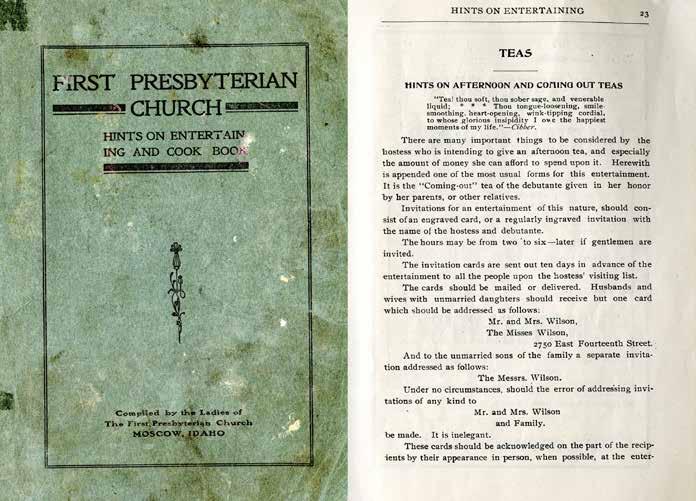
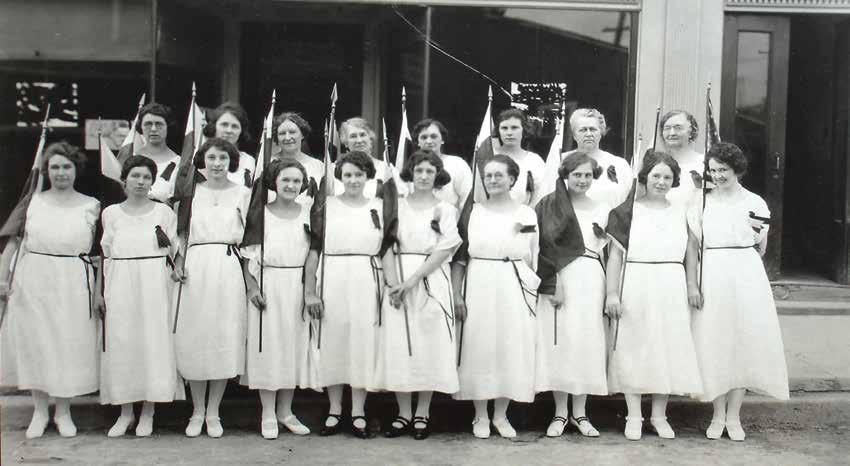
Home&Harvest | Jan/Feb 2023 39
Above - Members of the Bovill Ladies Club at the Maccabee Convention in 1923 Below - Hints on hosting teas from the First Presbyterian Church Hints on Entertaining and Cook Book.
Other factors included altitudes, humidity, and pans used, which are still factored into baking today. Not everyone was going to have the same oven, wood, or pans available, so bakers had to tailor recipes to their own needs. As technology improved, kitchens ditched wood burning stoves for gas and electric. By the late 1920s, most new homes were built with electric or gas stoves/ovens. With so much variation, you could not rely on the time to bake being consistent with different appliances in use and various other factors.
Many of the cookbooks included in the LCHS Collection come from ladies’ groups and organizations associated with area churches. For example, the cookbook put together by the Lutheran Church contains many Swedish recipes, owing to the fact that most Lutheran families in the area had ties to Sweden. The collection contains books from different Moscow churches, civic clubs and service organizations, granges, sororities, local companies like the Washburn-Wilson Seed Company and Idaho Pea and Lentil Commission, music ensembles, Moscow library patrons, and others. These collaborative cookbooks detailed multiple family and community practices inherent to that group. Many feature regional ingredients such as peas, lentils, and huckleberries. So many women’s groups throughout the twentieth century illustrate how upper class women undertook different charity and community based efforts, many of which have cookbooks in our collection: The Women’s Civic Improvement Club of Bovill, church ladies’ aid societies, Women’s Club of Viola, Dry Creek Welfare Club, Moscow Jaycee Ettes, and the Ladies of the W. H. M. Society in Troy.
It’s no surprise that most of the community cookbooks come from women. Historically, housewives have been the cooks, while commercial kitchens were run by men. This division references the divided gender roles between the domestic and the public spheres that persist in society today. Now, anyone can cook, but the patriarchal expectations run deep and influence social understanding of “women’s work.” The language in cookbooks captures those ideas quite well and one can view the evolution of our gendered ideas of who is in the kitchen. Of course, society today has vastly improved, but these gender roles continue to permeate society and criticize women who do not fit the typical “housewife” imagery that cookbooks perpetuated for generations. Some of the early twentieth century books also contain etiquette tips and hints to host the best gatherings, complete with decor suggestions, recipes, manners, and invitation language. All so the hostess can throw the best party. Of course, food and culture is a vast topic for discussion, and I merely skimmed the top. But hopefully this short insight has illustrated how cookbooks are, in fact, historical documents containing clues about the past and how current trends may be documented. Cookbooks can inform ideas about religious practices, historical events, materials available, immigrant experiences, technological capabilities, and the evolution of our gendered perception of “women’s work.” Cookbooks are also practical ways that students can learn about history and heritage. Cooking from historic recipes brings up questions or challenges that we no longer face. Perhaps most importantly, cookbooks can connect use to our ancestors in truly unique ways. Cooking a relative’s favorite recipe honors them and the culture that we came from.



Global KO2M Championship
Whittington Center in Raton, NM
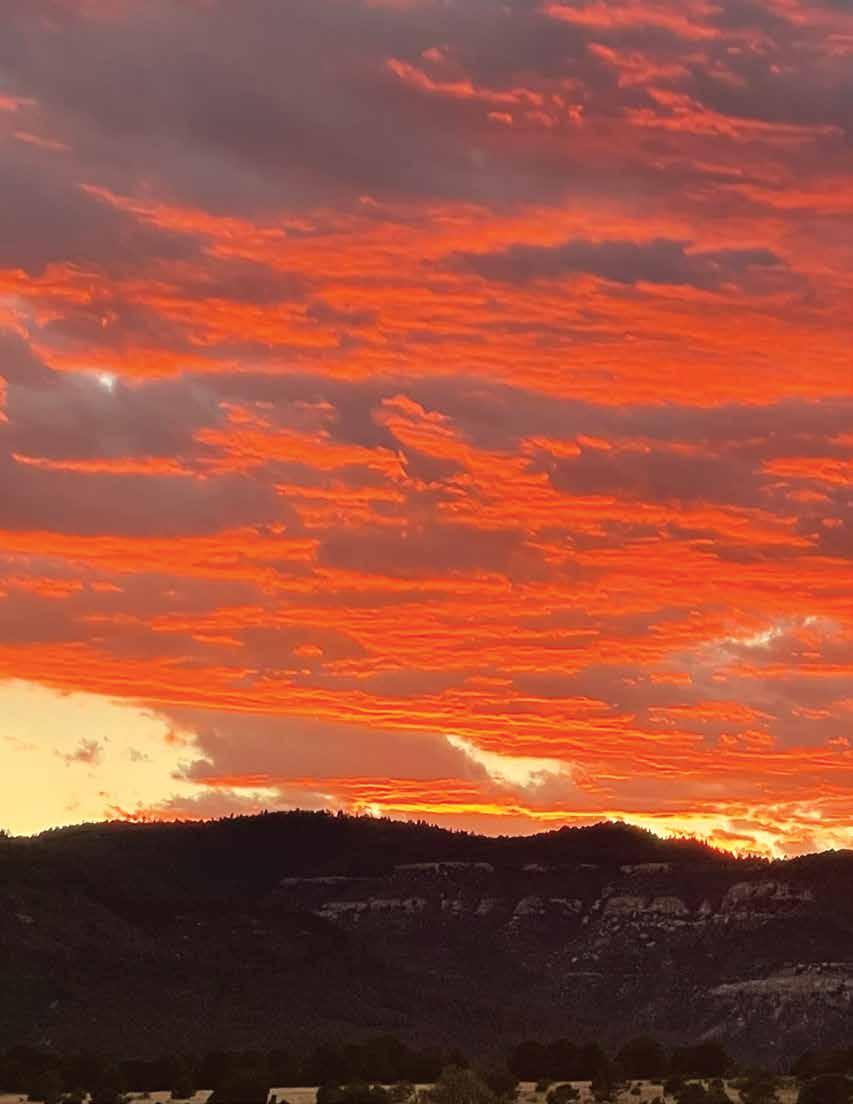
by Chad Kinyon
This is the first one of the articles in this Extreme Long Range Shooting series that doesn’t seem to want to be written. I’m not sure if it’s because I accomplished my bucket list goal of shooting at the Global King of 2 Miles Championship with arguably the best marksmen in the world, which was amazing, by the way. Am I done? Not by a long shot! There is just too much competitor in my DNA to let it go. Kind of like a hound dog and a porcupine; I just can’t leave it alone. Let me tell you why.
When I started down this path, I was just a guy who always enjoyed shooting sports of all types and ran across a series of videos on YouTube that interested me. Now, to be honest, when my family got together, we would almost always shoot targets of some sort with various weapons. In that honesty, I will also admit both my dad Roger and brother Roger T., would always beat me when it came to shotguns and hunting rifles, and probably still will with these types of weapons. By the same token, I had become more proficient with a bow or a pistol. My sister Wendy has recently taken up shooting a handgun, but she seems to avoid any family competition, or at least so far. So from the time I was maybe six, firearms have been part of my family life and the friendly competition that goes with them. So I guess that is where the root of my pursuit of shooting competition comes from.
I’m a big enough person to admit that when I play, I play to win, and I hate to lose, and as one of my second-place trophies says, “Best of The Losers.”
It’s that bitter pill that won’t go down and gets jammed up part way down. Realistically a person can’t expect to win all the time, but it should always be the goal.
When I moved away from The Palouse in 2003 to Southern Nevada, I left everything and everyone I knew to pursue a career. This forced that part of my life to get shelved for a while. Sure, when I was home visiting, we would head to some range, and that friendly competition was back on. At this point, I had some nieces and nephews that were roughly the right age to get in on the fun. I digress, but you get the idea that it is a generational thing in my family, which is now starting with yet another generation. My ELR family has partially filled the void that the move left in my life.
When I arrived in Raton, NM, on Sept 21, 2022, to a degree, it was like coming home. As my “family” came rolling in from all over the country for the grandaddy of all ELR competitions, where we would crown a new King/ Queen, yes, there is literally a crown made from bullet flowers. We greet one another with a firm handshake followed by big heartfelt back-patting hugs. Of the 85 shooters accepted into the competition, I knew maybe 40 or so and probably know of another 30 by reputation or name recognition. Teams like John Beloit and myself are not the norm in this group. We don’t have team jerseys covered with the sponsor’s names and support. We are just a couple of blue-collar guys that earned their way here on their own effort. So let’s dive into how the trip went.

I left Las Vegas a day early with Temple’s Jeep Wrangler loaded with all my gear. This marked a couple of firsts. This was the first road trip in this vehicle since she had just got it a few weeks prior, and I was making the trip solo. After promising to not hurt her Jeep several times, I was on the road. I will meet up with my spotter John Beloit, as well as Kasey Jones, Stan Cutsforth, and John Snodgrass in Raton since they are all traveling together from the Oregon area. Stan, Kasey, and John S. all shoot for team Leupold, but they have accepted John B. and me in an unofficial capacity with their team in that they will freely give advice on what we are doing right and as well as what we are doing wrong. I can’t thank these guys enough for the help they have given along this journey. The trip To Raton, NM, was for the most part uneventful except for what I’m calling a Divine Intervention. I’m flying down I40 near Flagstaff, AZ, and suddenly, something “told” me to exit the freeway to get gas and use the restroom. Maybe it was just my bladder, or perhaps it was God looking out for me. Before I exited the freeway, traffic was flowing freely at about 80mph and not bad at all. However, it had started raining fairly hard. After gassing up, using the restroom, and buying some Twizzlers, I entered back onto the freeway. I was immediately met by very slow-moving traffic. This stop-and-go traffic continued for maybe a mile or two until I arrived at the bottleneck. Two semi-trucks collided, causing their trailers to get opened like cans of tuna, and the contents were spewed all over the freeway. If I hadn’t gotten off the freeway when I did, there is a good chance the timing would have been right to be in the middle of this mess. Either way, thank God for making my bladder the size you did. Like Bugs Bunny, I made the left turn at Albuquerque onto I25 north, which will take me through the mountains around Santa Fe and eventually into Raton and the Whittington Center, where I’ll be staying. After checking it at the main gate and paying for my room, I ventured on to Competitor Housing. Navigating the center was much easier this time since I had just spent a week here at the end of July. These housing units are set up a little differently than the cabins we were in last time. These units have a shared living room and 3 wings that house 10 people in each wing. The wings have 5 bedrooms each, a kitchen, with men’s/women’s showers and restrooms. The room I was sharing with John has 2 twin beds that can be considered extremely firm. This led to several nights of getting maybe 2 hours of sleep per night.
Sept 22, 2022
Although the range we will be using for the match was closed, so the targets could be put up on the cliffs above the 1000-yard berm, the sight-in range would be open. I got up early and was off to the site-in range since I knew it would get hectic as people started arriving for the match. I set up my tall target to see how my offset would be affected by the 6300’ altitude and cool September weather. It’s a little tricky to sight in a rifle that hits 35.5” above the aim point at 100 yards, but I have a system that seems to work. Upon completing my session, I slightly adjusted my offset and bullet speed in my ballistic calculator. The four-shot grouping measured .34”. I think the rifle is ready to go. Now I need to get myself ready. Mostly that meant getting some sleep. Later that afternoon, “The Tribe” came rolling in one after-
-another. Since I was already settled in, I helped them unload what needed unloading, visiting, and making a few cocktails which I had hoped would help with that sleeping thing. It didn’t. We just got wound up and loud. After going to bed somewhere around midnight, I got up around 3am, not having slept yet, and went into the living area where Sportscenter was on the TV. I laid down on the couch and finally fell asleep. Waking up around 6am by people moving their gear out to their vehicles, but at least I got a couple hours of rest. Time to start this dance.
Sept 23, 2022
Unlike other matches, the KO2M doesn’t post the shooting order or the distances the evening before. According to Alex, the guy running the show, it’s because we will be shooting in two groups in the prelims. One group on Friday and the second on Saturday. Each two-person team will have one member shoot each day. If he posts the complete firing order, the folks that don’t shoot until Saturday might skip the safety meeting and sleep in. This is unacceptable from the match director’s point of view. It worked like a charm, as everyone was there waiting to see what day and in what order they would shoot. I drew #40 on Friday, and my partner, John, would be #17 on Saturday. This placed me near the end of the shooting order on day one, giving the wind plenty of time to get stupid and start playing its tricks.
I tell myself that I will sit on my spotting scope, watch every shot taken, and try to learn what I could from everyone’s hits and misses. I started out good for about 3 shooters, and then there were just so many darn people I wanted to visit with or meet. I’m not usually an overly social person, but when I’m in thick with my people, it’s a whole different story. As I was rummaging around in the back of the Jeep for God only knows what, I heard voices from a few vehicles down. I thought to myself those guys can’t be from around these parts with those accents. I need to go say hi and hear their story. Enter Taff Roberts and Giles Cross from Billingshurst in West Sussex, UK. Taff is a former Royal Marine Commando that is now an instructor for the London Metropolitan Police SWAT team. These two had loaded up their gear and hopped a plane across the pond to join us here in New Mexico, as this is the Global King of 2 Miles Championship. We visited for a few minutes, I asked them to sign my plate, and Taff gave me a very cool challenge coin from the London SWAT Team. I, in turn, handed them both North Idaho Precision Shooters stickers that I keep in my range bag.
Now, the plate I just mentioned is something I have only done a couple of times. The first time was back in Utah’s milk jug shooting days with LRSU. This is the second time since I felt this moment needed to be recorded regardless of its outcome. I had an 18” square piece of aluminum plate that I painted gloss white (just like the target plates), placed a KO2M, and Whittington Center stickers on it. I had a bag full of various colored Sharpie markers. As I visited with people, I asked if they would mind signing it. Even though I didn’t get all 85 shooters to sign it, I will treasure this “Bucket List” marker for the rest of my life.
As John and I started moving my gear into our chute on the firing line, the possibilities that lay before us were without limit. The format for the preliminary round would be slightly different than previous matches. Today each of the four targets would be allotted three shots each for points, but you have to hit each distance to-
Sept 21, 2022
Home&Harvest | Jan/Feb 2023 44


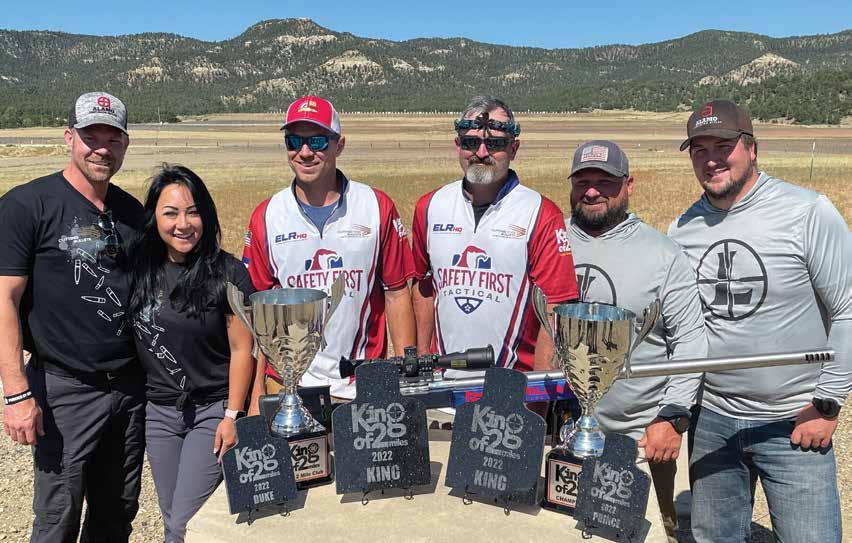
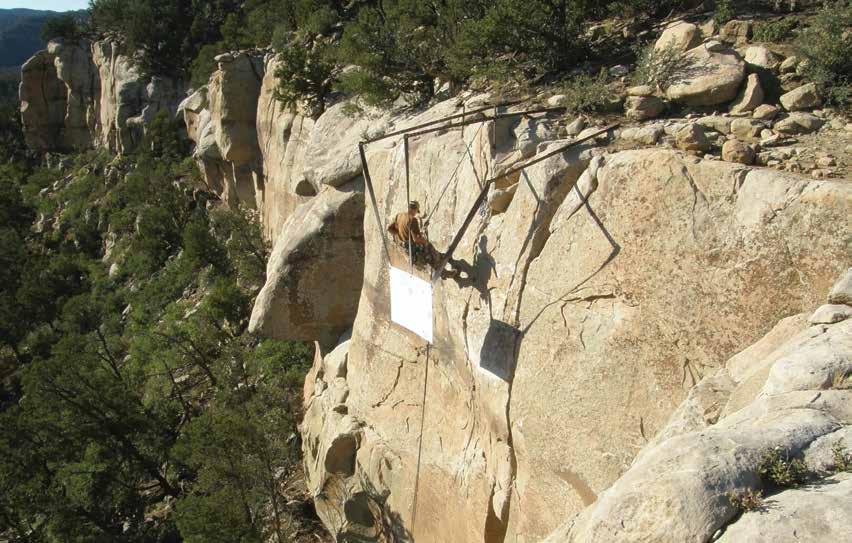
-move on to the next target. For example, let’s say a person doesn’t hit a target in three shots. They must continue to shoot at that same target until it is hit, or they are out of bullets or time. If they hit on shot five, they get to move on to the next target but receive no point value for T1. In addition, they will have used up two extra rounds, which will be subtracted from the back end. It is possible to shoot all 12 rounds at the first target and have a score of zero. This would be my worst nightmare come true. But this possibility is the furthest thing from my thoughts. Nothing but impacts; let’s clean the course is what’s in my thoughts as the first round gets sent down range.

Round number one landed 3.25 seconds later, just four inches off the left side of the plate at 2,097 yards. The elevation is good. We just missed the wind call by a smidge. The next round was already to be chambered as I made a slight correction. Round number two was dead center, left to right of the target but just over the top. Come on Kinyon, this is the last one for points, so make it count. Round number three was the perfect combination of the first two landing just slightly right of dead center target. Transition to T2. In a similar fashion to the first round on T1, the first round on T2 at 2376 yards was about six inches to the left and probably six inches low. This time I am just making an adjustment to my aim point. Instead of aiming at the center target, I moved my aim point to the top right corner. And chambered another round. Round number two found the mark. Impacting the target just right of center. “Send another one just like that,” chimes John from his spotting position. Round number three had a similar impact on the target and caused it to jump similarly, but this time there wasn’t a confirmation from the tower bell that I had hit it. More on that later. I had made my impact, and I was on the move to T3.
The first round on T3 at 2550 yards landed to the right, but we were lucky enough to see some splash about three feet to the right of the target. “Check the wind John,” I said. Sure enough, the wind flag hanging off to our right was limp. The wind was gone. Something I hadn’t planned on is that when you are in the chute, you have metal dividers on both sides to divert the muzzle blast and keep it off the other shooters. This makes it impossible to feel the wind switch directions. Another lesson learned. So I measured it out in the reticle and made corrections. Chambered another round and sent it. I had the windage right, but the round went high by about two feet. One last chance, so time to make it happen Captain. Round three impacted the target in the upper left quarter of the plate. That’s an impact and time to transition to T4.
By the time I settled in on T4 at 2668 yards, it had only been hit six times by the first 39 shooters. T4 defended itself well as I failed to leave my mark on its brilliant white paint job. My round was over. Although I can’t do the math in my head, I know enough to conclude that I missed making the finals, meaning that my KO2M experience was over for the most part. To qualify to shoot on Sunday, you have to be in the top 20%, which would be 17 out of 85 shooters. By the same token, I had watched enough shooters to know I would probably finish somewhere in the top half of the pack. Now I could make some excuse and say that’s pretty good considering the field of players, but we all know it would be a BS excuse. Participation trophy be damned; I want the crown. There, Temple, I said it, and you know I mean it. She has always contended that I might be just a little too competitive for my own good.

This is a team sport so remember I will be spotting for my teammate John tomorrow, and who knows, maybe he can put something together to get us into that top 20%. While we were packing up and getting ready to head back to our accommodations, the day-one results were made available. Naturally, I wanted to see how I had placed. I was sitting in 24th place. Immediately I noticed that the scorer had missed my third-round impact on T2. Was it going to make a difference and put me in the finals? I doubt it. Would it make a difference in my final finishing position? Absolutely. So I filed my first appeal to the governing body of KO2M to have this reviewed. After all, I had a cell phone video that clearly showed the impact.
Sept 24, 2022
My teammate John Beloit is relatively new to this thing we call ELR shooting in that it is his first year competing. He is shooting a new, to him, 416 Hellfire rifle that was a little on the late side getting put together. He got everything put together, and a load worked up in what I would call record time. The only guy I know that could have pulled it together in less time would be Kasey Jones. Anyway, it’s into the chute we go for John’s preliminary round.
John settled in on T1, applying what we learned yesterday on my run the day before. I would be checking the wind flag after every shot. He let out a deep, cleansing breath, and we were off. First round, Impact. Second round, Impact. Third round, Impact. He had cleaned T1, and that’s one heck of a way to start the day. Transitioning to T2.
After slightly adjusting his bipod to get the correct elevation, he settled in with that same deep breath. First round, just off the left edge. Second round, just off the left edge, Third round, impact. Transitioning to T3.
T3 is roughly the same height on the mountain as T2, so the transition was just a matter of panning the rifle over to the left. Again with that deep cleansing breath and it’s go time. First round, Impact. Second Round, Impact, Third round, Impact. He had cleaned another one. Damn, he’s really making my job as a spotter easy. Transition to T4.
T4 had defended itself well through the entire match and wasn’t about to just give it up because John was on a roll. John’s First round went low and left. He made corrections and sent round two, elevation was spot on, but he was left. One last round to bring it home, and he went left again. “Well, that was one hell of a run,” I told him. “I think you just made the big time, and we are going to the finals.” When the scores came out, he had indeed made the finals, and not just by a little. John was sitting in ninth place with three targets to shoot five rounds each on Sunday for the crown. I’m sure the odds makers wouldn’t be picking us to win this thing or even be here for that matter, but we are. So into the fight we will go, like the third monkey on the ramp to the ark, and brother, it’s raining. We will worry about that tomorrow, tonight we celebrate!
The firing order came out shortly after the last shooter finished on Saturday. John drew the 17th and final position in the finals. He would fire the very last shots before the close of the 2022 KO2M Championship.
Sept 25,2022
Our wing of Competitor Housing was up well before sunrise because we were shooting in the finals. While John was sitting in 9th, Stan Cutsforth was sitting in 2nd place after hitting 6 shots in a row, starting on T2 and ending on T4. Stan was just a rough 15,000 points back. While John and I would be a long shot, Stan and Kasey had a real shot at the crown. Stan is where I would have put my money if I was a betting man. I had seen firsthand how he could work this venue. Stan started his final round with 3 in a row on T5 at 2727 yards. As he moved onto T6 at 3164 yards, everything was off just enough that it didn’t count. But hitting the first three shots out of the gate would be worth a lot of points. Not sure if it will be enough because Justin Wolf had been sitting in first place after the preliminary round, and with a second-round impact on T7 at 3525 yards, he might have cemented his position. The math was too hard to figure out who was in the lead at this point.
It was time to close this thing out. John and I moved his gear into the chute and got set up. Today we had 3 targets that would receive five rounds each for points. Same as before, John would have to hit to move on. Well, this isn’t a Hallmark movie folks, and our hero didn’t win the day. John got an impact on T5 on shot eight, which yielded no points. T6 is where the wheels came off the bus. In fact, we couldn’t even see where John’s 525-grain bullets were hitting. Hindsight being 20/20, taking his scope caps off and making some adjustments to accommodate a prism that he didn’t have time to zero properly was a very bad idea. Epic on the scale of bad ideas. Lessons learned.
The appeal that I had filed had been denied. When I received the video via email from Alex, that third round that had been in question clearly went over the target. It had bounced off the rock bluff and into the back of the target. It was a hit, just on the wrong side of the target, and those don’t count.
So how did “The Tribe” finish in the field of 85 you ask?
Stan Cutsforth, 416 Hellfire, finished 2nd
John Beloit, 416 Hellfire, finished 16th
Kasey Jones, 416 Hellfire, finished 22nd
Chad Kinyon, 375 EnABELR, finished 45th
John Snodgrass, 375 Cheytec, finished 62nd
As I reflect back on this life experience, I feel like, in a way, I did win a crown of sorts. I have lifelong friends that mean the world to me. I will continue my quest for the actual crown in 2023.
Home&Harvest | Jan/Feb 2023 48
The 2023 Subaru Outback.




With standard Symmetrical All-Wheel Drive, you’ll always be able to reach the next adventure.
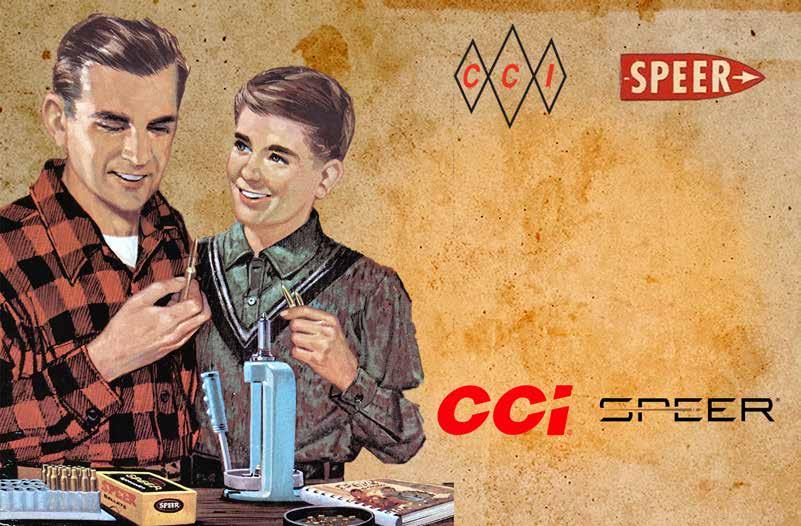
AReading For You
by Annie Gebel
The sixth card in the major arcana suit of most tarot decks is called The Lovers. It has a positive romantic vibe to it when drawn upright, but it’s not only for actual lovers. This card can be applied to friendships, career decisions, and even your finances. So, think about what you might want some insight into and choose one of The Lovers to gain a little guidance on the subject.

The Lovers: The Light Seer’s Tarot, by Chris-Anne
This card oozes magic! If you’re asking about a romantic connection - go for it, expand into it, but don’t just go for the physical aspect of things, really seek out intimacy with this partner. That’s where the gold is! As far as friendships are concerned, you might feel almost a magnetic connection to someone - even the sensation that you’ve known each other forever even though you’ve only just met. Lean into that and enjoy the comfortable feeling of already relating to a new friend. As far as your career is concerned, think about the relationship being rather-
Home&Harvest | Jan/Feb 2023 50
x b x
-than you and another person you work with. Consider where that magic feeling is in what you do? If you’re not in love with your job, can you change jobs? Can you bring more of your joy to the position? Can you dress more authentically? Can you find ways to laugh more? Keep playing with those questions to inform your career decisions. And, lastly, now is the time to get intimate with your finances again. Hold off on big purchases if you can for a minute and just get a look at what’s happening with your accounts and how you can whip up that intense magic with your money too! Look ahead and get excited about increasing your bottom line and being able to treat yourself in the future.
The Lovers: 5¢ Tarot, by Madam Clara
This version of the card shows some intertwined snakes, a moth, and an apple. The apple gives me a little Adam and Eve vibe, which is interesting as a relationship guide because, according to the story, Eve led Adam astray. But, the apple could also be about nurturing a connection or having a healthy relationship with yourself. The moth is a symbol of both determination and vulnerability. These can seem opposing, but are both necessary for a relationship to succeed. Lastly, the snakes represent the birth, death, rebirth cycle. This idea of change points to a new connection or new level of commitment either with a career step, a partner, or even, again, with yourself. There may be some discomfort with having to slough off an old skin, yet the renewed and/or expanded love is worth it and you will likely have a sense that something even better is coming!
The Lovers: The Muse Tarot, by Chris-Anne
This card is rich with vibrant colors and textures. There are some arms and legs in the forefront that hint at entanglement, but the people pictured are in the shadows of the background. They could be catching each other’s eye from across the room, but their distance implies a choice hangs in the air. Do they walk toward each other and into the blossom of the lotus? Or do they let this opportunity slip by, only feeling the temptation and anticipation but not the full experience of connecting with each other. Of the three cards shown today, this one actually feels the most specifically about two people in a romantic, or at least romantically charged, relationship. The vibrancy and opening of the blossoms doesn’t speak of career choices or finances. This card is about attraction and the invitation for you, if you chose this card, is to find the spark of suggestion and fascination in your relationship. If you want to continue choosing each other, continue finding ways to explore all the senses together - color, texture, taste, sound, scent. If your question wasn’t about romance, I feel like a similar invitation is still there for you. How can you bring joy, anticipation, and excitement to your job or your financial outlook for the month? Play with the senses. Try looking at the bills only after you take a hot shower and are wrapped in a fluffy robe with creamy hot chocolate to sip. Bring the colors of this card into your life and watch connection and expansion happen!
Hopefully you’ve gotten a little nudge from one of these Lovers cards. Something to get your heart beating with excitement. Something to recharge a part of your life that needs the boost. Something to help you fall in love - with your job, your budget, your boyfriend…whatever! Just fall in love!
Home&Harvest | Jan/Feb 2023 51
greatgrapes
 By Trent Morgan
By Trent Morgan
IIt has been a slow start to a good old-fashioned winter for many of us hobby farmers and backyard putterers. As the thoughts of warm afternoons fondly drift through our recent memory, and the hankering for upcoming potential outside projects grows, I thought I would share an idea that I tried with good success in my hobby vineyard. As a third-generation orchardist and gardener, I know many local readers feel the same yearnings, having distant “roots” in horticulture. My great-grandparents planted one of the first commercially producing orchards in Moscow, Idaho, for which Orchard Avenue is named. Though my professional pursuits have taken me from coast to coast, this passed-down passion for growing has led to much experimentation. This fun hobby has been assisted greatly, most recently, in my pursuit of Master Gardening with the University of Idaho’s Extension Master Gardener Program. The project I will explain “fed” my growing passion for wonderful, juicy, seedless table grapes. I love experimentation in the garden, and as the saying goes, “even a blind squirrel can find an acorn on occasion.” In this case, a juicy clump of grapes. Nothing beats a freshly-picked cluster of vine-ripened seedless grapes. These cultivars have been grown for table and cup fare since history has been recorded. They have great backyard appeal to us, because they are hardy in most climates, work well into landscaping, self-pollinate, and most importantly have lots of healthy eating potential. Some may be aware that the climate in and around Lewiston, Idaho, was recognized early on by viticulturalists. In fact, by the early 1900’s it is reported that over forty varieties of grapes were being grown in the region, and local wine was being recognized worldwide. Prohibition put an abrupt end to these ventures. However, as we have all seen, viticulture is back, and it is time to consider joining in the fun!
Grapes are easy to start for even the novice horticulturalist. I added five varieties of table grapes to my small orchard several years ago from prunings I received from a friend. The real fun has been learning and watching nature do all the work and to see the delight in friends’ eyes as they pop the juicy seedless delights or guzzle a chilled glass of fresh juice. I take cuttings every winter to start new plants for friends asking for some and to continue to promote healthy eating. Of course, you can make wine, but that seems like a lot of work to me that is best left to the local professionals.



Grape cuttings will root on their own given the right conditions. The problem I have noticed is not that it is hard to get starts going, but that some techniques work better than others, particularity making sure that root growth supersedes leaf propagation. Some processes are messy and time-consuming; others are limited by outside weather conditions. Other methods work great but can be expensive in what is becoming a very popular hobby-growing industry that is forced to increase prices in our inflationary economy. Wanting to keep costs low by using material on hand, and also not having much tolerance for tedious, time-consuming methods, this idea worked great for me. It might work for you, too.
A cutting from a grapevine will become the same exact grape from its “parent.” You can use either dormant hardwood cuttings or green summer cuttings to do this. I prefer dormant cuttings because you are using what you would discard after winter pruning. Some people try letting cuttings sit in water or just jam them into the soil, but I haven’t had that work for me. One standard technique to get cuttings to root is by planting cuttings into trays with individual plugs and use a heating mat to induce the vine to sprout the roots. This works well if you want to buy a heating mat and those supplies, but they can be expensive. I also found it takes quite a bit of fuss, having tried it using a doggie-bed heating mat, although it did work—sort of—on a small scale. Meanwhile, I read how large commercial vineyards plant their cuttings en masse, in upside down groves, letting the heat of the springtime sun stimulate root growth. This also serves the purpose of keeping what will become the leafing portion of the new vine from sprouting before the root has a good start. The idea came to me that I could do this on a small scale using some old plastic pots and tubs that I had kicking around. I figured I could use the same technique as large commercial vineyards in the late winter when cuttings are available but avoid digging messy planting holes in my frozen, mucky garden.
First, a few basics and a disclaimer from a hobby viticulturalist. The following steps are a rudimentary variation on common knowledge for those of us “side-hustling” fruit growers. I imagine there are those, both novice and professional, who may cringe at my ideas and they are welcome to do as they like. One very real concern for all of us is that we never propagate diseases, and to that end I am always committed and cautious. Although grape cultivars in many ways suffer less risks from disease and infestation than other flora in our gardens, you should always make sure your cuttings come from a healthy source and only cross state lines when and where permitted. Now, a final caution as you seek cuttings that will lead to vines and a harvest to your taste; you must be aware that many of us are rather cultish about what varieties we love, so you may have to commit to a long conversation. Likely, however, you will find the payoff is that you may receive great advice on your new project and a free cutting to boot. Once you have access to cuttings, make sure of a few things. Importantly, once cut, you will have no idea what variety it is if you do not label them. Bring masking tape and a Sharpie, along with your sharp pruning shears. You will not see grapes from that potential vine for two years, which is a long time to try and remember. Also, research and decide what you might want to grow. I decided on all seedless varieties except for one standard juicing grape—Concord, of which I have fond childhood memories. I also wanted different-colored varieties as well as those that matured at different times in the late summer and fall. It might be easier than you think to find folks with varieties that fit your-


-palate, or you can always buy them from your favorite gardening catalogue. Sadly, those may come already rooted and rob you of the fun of rooting them yourself.
As you procure your cuttings from a desirable source, clip them from healthy dormant canes, about pencil-width in diameter and with two to three buds above the cut. Buds are bulges at intervals of the cane, and are future leaves and potentially fruit. If you are at a friend’s vineyard, take care to gain guidance in taking cuttings and do so well after winter and early spring’s last hard frost which may damage exposed wood left behind. Each cutting should be about eight to twelve inches long with a clean, ninety-degree cut a quarter to one half inch just below a healthy bud. Leave enough cane so that you have room to make a fresh cut right before rooting them without cutting into the bud. Here is where good sharp and clean sheers come in, so you do not mash the cane or transfer disease. Cut the other end a few inches above the second or third bud, whichever is closest to the cutting length you desire. Do not make this second cut straight, but at a noticeable angle, making sure now that both ends show nice, green-tinted wood flesh inside. Now you know what variety it is and which direction to plant it in your soonto-be-created dirt nursery. Bundle your cuttings and you are ready for phase two of the project. If you need to store them for a few weeks, make sure they are moist and cool.
It is time to gather the rest of your materials from the barn, garage, under the deck, or wherever you may store a couple of large plastic bins and the right amount of twelve-or-so-inch diameter potting pots, depending on the level of enthusiasm you have for the project and area you have to cultivate grapes. Because I never throw such reusable garden items away, it did not take me long to find what I had in mind, and I had them in hand after shaking out a few surprised slow-moving spiders. I did spend a few dollars on some potting soil and root growth stimulating hormone. You may have your own homemade potting soil recipe, but for this project, nitrogen balance is less important than having a light soil which will not hold too much moisture and will drain well. Potting mix with peat moss works well, although it is one of the few applications where I still use peat-containing mixes. You may need several bags. With regards to rooting hormone, I have experimented with several types and have had the best luck with liquid products. Make sure and follow precautions when using these chemicals and wear gloves. Now, for the fun!
First, make sure your cuttings are at least six inches shorter than the depth of your large plastic bins or tubs. The goal is that the rooting ends be held upside down in the planting mix about four to six inches from the top. After punching holes in the large plastic tubs for drainage, put an inch or two of your potting soil in them and set them aside if you are rooting multiple varieties. If you are only rooting one variety, you could skip the step of the smaller containers, and just place the hormone-treated cuttings directly into the tub as next described. Because I will root multiple varieties at a time, I make sure each variety goes into its own labeled pot. If this is the case for you, take your twelve to fourteen-inch diameter plastic pots and loosely fill them about half full of potting soil. One variety at a time, dip each newly-trimmed, flat-cut rooting end in the rooting hormone and then stick it ROOT SIDE UP, or upside down, in the potting soil. The angled “spear end” will pierce nicely into the potting soil.
Continue the process until you have all of your varieties happily standing on their heads. Remember, the cuttings are going in upside down, with the flat-cut, rooting end up. If you have multiple pots, once filled with cuttings, place the entire pot into the larger bins. You now have a plastic bin, or bins, with a bunch of eager rooting ends looking up at you, longing to be covered with your fine potting soil. They anticipate solar warmth from the spring sun in the form of electromagnetic radiation to stimulate a magical process where white root tendrils will emerge from the bud adjacent to the end you have cut and prepared. It is time to say goodbye for now and cover them up in a nice bed of soil, so go ahead and fill the bins up around the pots: up, up, and over the top of the rooting ends, with hopefully a good three to four inches of soil covering them to the top of the bin. It does not matter the time of year or your climate at this point. The canes are dormant and will wait for the right conditions of warmth and the sun’s rays to begin rooting when Mother Nature gives the go-ahead. The main thing now is to make sure the bins are placed in an area that will benefit from spring conditions. When that happens, it will be critical that you keep the topsoil well-moistened but not saturated. If the area is not exposed to rain, I try to use any spring rainfall to remind me to go give the bins a good soak. Setting the bins in a sun-exposed and wind-sheltered area works great. I made a DYI tilting awning off the south side of my shop that works perfectly to collect heat, even on cool days. When the weather warms up, I make sure and keep the cover open to avoid cooking the grape starts. They like warmth but not excessive heat that might completely dry out the topsoil. Now, leave them alone except for watering. When spring finally arrives, you smell trees budding, and you start to see the first early varieties sprout in your garden, begin checking your bins for signs of growth. It may take weeks to months depending on when you did the planting, the amount of spring sun, and how much soil is covering your rooting ends, but be patient. However, do not wait too long, because once they begin to root, they get busy! You will quickly have a tangled dense mess of roots that are hard to separate and can be easily damaged. A key sign will be a few roots breaking through the tops of the soil, or you can do some careful excavation to check on the little ones’ progress.
On birthing day, collect as many individual pots that you might need for your new grapevines, aware that spiders now have upped their scurrying abilities. You will need a tarp and possibly more potting soil mix if you have an abundance of new starts to share with friends and family. Throw down the tarp and gently ease the bins onto their sides. Begin to gently free the pots or individual rooted canes, or both. With luck, you will have aggressive root growth but no significant sprouting of leaves from the two or three buds on the cane. Continue with your meticulous labeling, especially if you have multiple varieties. The new plants can be transferred to individual pots to mature or gift, or can go directly to an area you have prepared. In their first year, leaves will form and send out a small vine or two which will grow amazingly well, requiring a small trellis to keep them off the ground. You can wait one more year if you like to construct a better one that will lead the vine where you want it to go. This project is yet another great opportunity to use resources and information at hand, along with your creativity, to help your new vineyard, big or small, succeed.
Home&Harvest | Jan/Feb 2023 56

people
of
the palouse
Let’s get to know our neighbors, those like us and those who are different from us. Please send any introductions to:
Heather@homeandharvestmagazine.com
by Gayle Anderson
Sabrina Bales
When I sit down to write, often where I think the story will go isn’t where it ends up at all. As I listen and take notes when interviewing, in my mind's eye, I’m mentally mapping out how the article will roll out… and then the words flow as I’m writing, and the story takes on a life of its own. And I realize, life is a lot like that too. Where we think we will go isn’t often the pathway that we end up on. Sometimes it’s due to circumstances, but mostly it seems it is by the choices we make. It may be fair to say this applies to a good portion of us and certainly yours truly. And that was exactly what happened to one amazing young woman whose story I’m inspired to share with you.
For example, when the choice of going to culinary school is suddenly moved to the side and you walk into the Navy recruiter’s office and say, “help me”. Well, your life story goes into a whole new direction that will forever shape you into the person you are today. With that, let me introduce you to Sabrina Bales, a 27-year-old woman who has two deployments under her belt, is currently in the Naval Reserve and is in the process of completing an undergraduate degree at the University of Idaho.
Growing up in Austin, Texas, Sabrina had just graduated from high school and was living with her mom while getting life figured out. Culinary school was her goal, and yet when weighing the pros and cons of that kind of career and lifestyle, it became clear that this wasn’t the path she wanted. Instead, having come from a long line of family members in the military, Sabrina, on a whim walked into the Navy recruiter’s office and promptly signed up. Within 3 months, she was off to basic training at the age of 19.
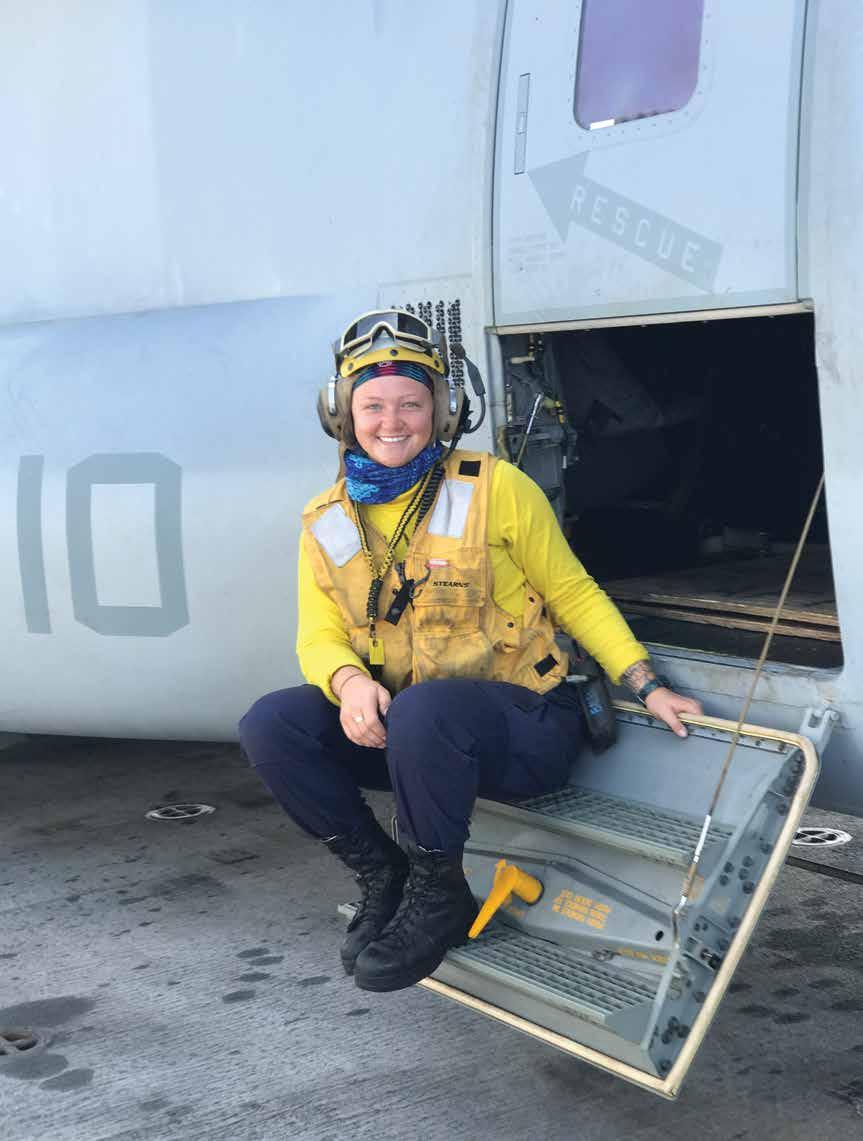


The structured military life was a good fit and Sabrina excelled. She was one of seven women in her division and through hard work, earning the respect of her superiors and subordinates, Sabrina successfully tested and was promoted to an Aviation Boatswain’s Mate Handler Third Class, a position she held for 1 year before being promoted to Second Class, the position she currently holds. Sabrina described the job as the person who is on the flight deck and oversees the aircraft for takeoff and landing. It is fast-paced and intense (think “Top Gun”). To get a better scope of her job and for those like me who are unfamiliar with Navy terminology, a Google search says this: “Modern aircraft carriers can launch aircraft every 20 seconds. That means the flight deck can get busy, so solid management and communication are essential to preventing chaos. As an Aviation Boatswain’s Mate – Aircraft Handling (ABH), you ensure smooth launch and recovery operations by carefully directing the movement of all aircraft. Supervise every turn, tow and park, and secure them to the deck. Wherever they go, you’ll be the guide.” (Navy.com) Impressed?
...think Top Gun... " "



I am. Sabrina describes her normal workday as being anywhere from 14-16 hours and sometimes as long as 18 hours. She would have 8 hours off, this time was used for sleeping, showering, eating or working out. Sleeping quarters were tight compact racks, bunks, which were stacked 3 high. All her personal belongings were kept in a six-foot by three-foot space. Being in close quarters with so many people is fertile ground for setting boundaries, standing up for yourself, as well as others. It also led her to be an official mentor for other women onboard, as well as for a few men too. A role that Sabrina felt made her a better person. They were mainly stationed in the Mediterranean and the climate was hot. Being fully geared up, head to toe, the only area unexposed was the lower half of their face and thus they all sported “beard tans”. However, the perk for long hours and brutal climate was getting to see other countries, experience new cultures as well as seeing amazing weather patterns and the extreme calmness of the sea.

heart
heart to
Reach
out to your favorite Lifestyle Specialist today!


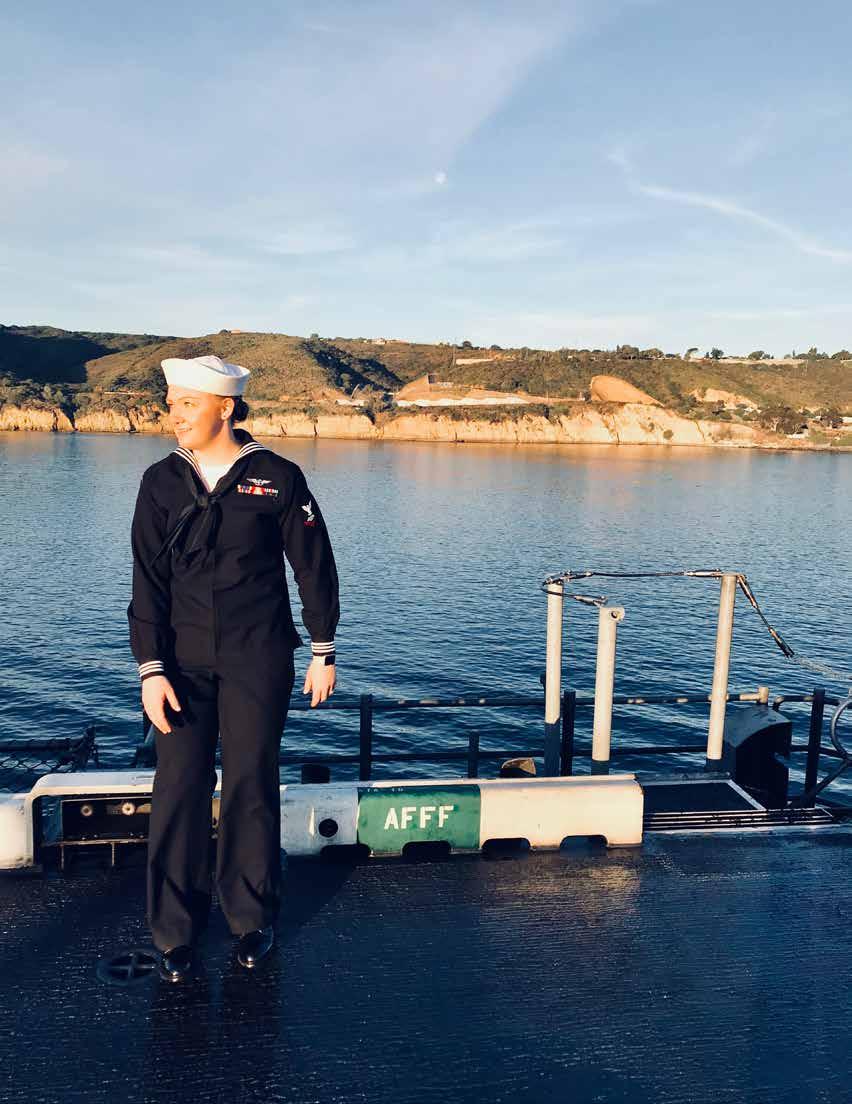
After the decision to separate from the Navy, the transition from a structured life of being told what to wear, what and when to eat, and what your daily duties were to becoming a civilian was difficult. Only to compound the extra stress of a life change, it was May 2020 with COVID-19 in full swing. Sabrina stayed with her mom and tried to adjust to a non-structured life as well as navigating a COVID world. Sabrina ended up enrolling in college via online courses and getting her Associate of Science in Environmental Sciences from Austin Community College. She was the first to complete a college degree in her family. Sabrina admits she should have gotten counseling to help navigate pitfalls of moving into an unstructured civilian life. A few bad choices were made along the way as well as bouncing around the country was the catalyst to move to Idaho to be closer to her parents who have made Idaho home since summer of 2017. Once in Idaho, Sabrina was living in a family friend's airstream and was very content with compact living. Sabrina being mechanically minded, bought an old school bus with plans to convert it into living quarters and do the “van life” with her two cats, Parker and Louis. However, fate intervened and as Sabrina was exploring the area, she drove through Moscow and saw the entrance to the University of Idaho. Her research showed that the university is home to the College of Natural Resources. On a whim, Sabrina shelved the school bus restoration project to try the college life in person. She said her advisors, Matthew and Billy go the extra mile for her as well as other veterans going back to college.



Today, Sabrina has a serious boyfriend, Kris, who she credits with providing her inspiration to pursue a Bachelor of Science in Conservation Biology with a minor in Fish and Wildlife Sciences. Sabrina said the minor in fish and wildlife sciences was added after going fly fishing on the St. Joe river near Avery, Idaho. When asked what the future looked like for her, she answered that after graduation slated for May 2025, that she wants to do stream and river restoration projects in Idaho or Montana.
While Sabrina loved active duty, the lure of civilian life has her excited about what the future holds. The wanderlust for traveling still has a place in her heart and new places and cultures are bookmarked for future adventures. Sabrina credits the military with shaping her into what she is today and that she was proud to have worn the uniform and served her country. Sabrina’s advice to anyone, “just do it. Don’t sit on the sideline wishing life was different, get out there and try something new, I wouldn’t be where I am today had I sat and waited for life to happen. You will never know until you try.” And on a personal note, “ditto” to Sabrina’s words of wisdom. Wishing everyone a wonderful new year.
Craft & Food Juries Now Open
Drifting

Drifting with the south wind
By Jacqueline Cruver
By now you know me as a reflective storyteller and if you would please indulge me, Tony Niccoli’s enlightening piece in the September/October issue, History Of The RV, has resurrected memories of a winter, spring, and summer calling one home until ultimately reaching the end of the road here on the Palouse 30 years ago.

1993 Sitka, Alaska
Cloudy gray light flooded the entry room of the upper unit of the duplex on Anna Circle through four very large windows. Ironically, this “sunroom” showcased silver rivulets of rain constantly cascading down the glass, distorting the view of a typical southeast Alaska neighborhood because it rains in a rainforest. Looking in any direction you would see dripping cedar trees, wild rose bushes, mud, gravel, children and grown-ups in rainwear and rubber boots, long puddles on asphalt, worn out tarps, and wet dogs. Inside the walls on any weekday morning were the sounds of a father hurrying off to work, one son getting on his rain gear to wait out on the road for the school bus, two small boys usually making the other cry, and an at-home-mother playing referee while performing her daily tasks.
One September morning was unlike the others. There was none of the usual humor and conversation was sparse. The air held a deep and heavy sigh. The Alaska Pulp Corporation-Sitka Mill Site had just announced it would be shutting down operations and 450 people would be out of work. We were one of those families. As it was a major employer of the community, it was clear it would have an enormous impact on the isolated town. Our landlord, knowing our source of income, had informed us that he would not be renewing our lease. It was up in less than 90 days but the final steps of closing the mill would keep my husband employed longer than that. We were facing the harsh and frightening reality of homelessness.
The decibels emanating from my two tots just faded into background white noise and I pictured the clouds as enormous gray whales that I knew were migrating down the Inland Passage to Puget Sound and on south to the warmer waters of the Gulf of Mexico. If only we could saddle up one of the 45 foot leviathans and ride them to sunny skies. We had actually looked at an old concrete hull sailboat for sale. The marina was full of people living on their boats but we were landlubbers. But land ahoy, good fortune came instead in the shape of an old but affordable 28 foot motorhome for sale in the local paper. We bought it on the spot. The looming problem to be solved was not the dated orange shag carpet but of course where to PARK an RV. There were no RV parks. We weren't exactly in a snowbird kind of community. Again, good luck smiled upon us as a 'for sale’ sign appeared on a lot two doors down from our duplex. Explaining our situation, the owner agreed to a month to month lease. Our survival plan was evolving.
So the sorting began; items to put into the motorhome, items to yard sale and items to lock into a container to eventually ship to who knows where because that was not an answer we had yet. Would we try to stay in Alaska or consider returning to the lower 48? When we had first moved from the Pacific Northwest to the Alaska Panhandle, the relocation package paid the shipping bill for a 40 foot container which easily held the household belongings of a family of three with room enough for our pick-up truck inside. Taking into consideration that we would be responsible for the moving cost this time, our only frugal choice could be a 20 foot shipping container that holds 25 cubic meters. Both the weight and space taken up determined what household items were kept and what would have to be left behind. I discovered there is an unwritten clause somewhere in regards to some patriarchal preferences being exempt. The large coffee cans of assorted nails, bolts and washers were among the “must takes” and the featherlight bone china cups and saucers that had belonged to my grandmother were to be liquidated. I’m not sure, but I don’t think that led to our divorce years later. We joke now that he is still using some of those nuts and bolts and I don’t really care for tea.
We did not have a clue about RV life, but his parents had been caravanning with their airstream for years. There were some tips shared about being prepared for mechanical needs that might arise but their traveling had begun after retirement and never with children. They did however always bring their cat Lester, who tolerated being tethered to a rock they carried to all destinations. They had learned that rocks can be hard to find in some places and that the rock needs to be too heavy to drag too far when Lester spotted things to chase like desert dwelling roadrunners. We were not headed for the desert but made a secure attachment on the motorhome chassis for our dog Max to be tethered. We crossed our fingers that if he saw something he wanted to chase, he would not drag the bus too far. So January 1, 1994, the fully loaded container was placed dockside, waiting for a destination and the fully loaded motorhome rolled on up a short muddy driveway to its new parking place. The goldfish bowl had been safely secured to the countertop and the skirting was quickly secured to the motorhome just before the first snowstorm. The wet dog Max, was treated to a newly constructed and insulated A-frame doghouse which my sons crawled into often to visit him. Max was a big black dog that-
-weighed more than my boys. A mixed breed with some Newfoundland, he always demonstrated more patience than I did with the constant chaos of their high energy. He never let them out of his sight. Their ages were 2, 3, and 9 when we entered this transitory period and I assure you that I could not have done it without him.
After a month of becoming proficient at domestic duties and child rearing in very limited space some challenges arose. Not from boredom of being inside the rig, but fascination with the outside of it. One clear sunny day, the kind where you can see each breath leave your warm lungs, my youngest son was awol from the other boys and they came to report it. We took a circle of the small neighborhood, my imagination running amuck. He was always the wandering one and open to anything that would entertain his curiosity. Returning to base camp and re-checking the dog house, movement caught my eye behind the RV. There he was, wearing one of his contagious smiles as he dropped the short handle sledge hammer back into his father’s bag of tools that had been left out. In spite of it weighing nearly his own weight, he had successfully made a racing stripe of very visible dents down the side at about the height of his happy little shoulders. I was so glad to find him that I did not know how to reprimand him for such an incredible accomplishment. Oddly, months later a huge hailstorm would pummel the other side, making both sides look very similar.
We carried on, settling into a routine of keeping fed, keeping entertained and keeping warm. The winter continued to get colder and snow and ice formed a frosty shell on our little home. As the winds continued, too many days of below normal temperatures froze all of the pipes. We accepted the loan of a rusty industrial size propane heater that sounded like a jet engine was positioned under the bus. I was still not phased. I didn’t need drains or running water. No. I was an Alaskan. We were an Alaskan family. I had birthed two of my three sons while living in Alaska. I had the luxury of a hospital, yes, but I felt kindred to the women delivering their babes in cabins out on the remote islands, getting their supplies dropped from noisy bush planes, and raising kids in float camps. They were known to be tough and I was determined to find that fortitude. I knew I could do it. This wasn’t nearly as harsh as I had seen up north in the interior. We did have roads here. What’s so hard about this? Then just as the pipes began flowing again, the lot owner knocked on the door to tell us the lot had sold and we had a week to relocate. Smiling my most understanding and accommodating smile, I thanked him, closed the door and folded. I was feeling like a cheechako, a greenhorn, and honestly just wanted a hot bath and the services of a good babysitter.
Again the universe provided sanctuary when an upper level manager at the mill, when told of our dilemma, offered a parking spot on some property the mill owned overlooking Sitka Sound. It had a level, fenced yard and was bicycling distance to the grade school. We were allowed to use the building on site for showers. Nice long showers. We were able to stay there until my husband's services ended with the company. The winter was surrendering to better travel weather and we prepared the vehicle for the next leg of our RV journey. We would get on the road! No work prospects had materialized so we would become mobile while the search continued. I stared out the window as if the answer was somewhere out there in the depths of the puffy gray clouds.
Home&Harvest | Jan/Feb 2023 68
A cozy place to call your own.
Complete your mortgage online in minutes at p1fcu.org and make your dream home into a reality.

disorders like insomnia, restless leg syndrome, or sleep apnea, Dr. Usha Nandhini, Sleep Medicine Specialist, can help.
• Obstructive sleep apnea
• Central sleep apnea complicating congestive heart failure
• Insomnia in children and adults
• Restless leg syndrome
• Movement disorders of sleep
• Narcolepsy
• Circadian rhythm disorders
• Shiftwork disorders
Talk to your doctor about a referral to Dr. Usha Nandhini. Palouse Sleep Medicine 825 SE Bishop Blvd. Ste. 201 Pullman, WA

(509) 338-6000
pullmanregional.org/sleep-medicine
am passionate about educating individuals on the importance of quality sleep as a prerequisite for a healthy life and eager to treat sleep disorders to help them achieve their optimal health.”
Dr. Usha Nandhini
NMLS ID #527990






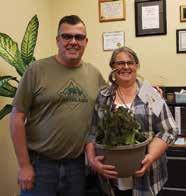


HOME LOANS | PERSONAL LOANS | BUSINESS LOANS | CREDIT CARDS LATAHCU.COOP Moscow | Kendrick | Plummer | Potlatch BE ST WISH E S & H APP Y N E W Y EAR ! Giving back to those we serve since 1989. COMMUNITY Is Our Business 800.248.8822 • inlandcellular.com
The decision was made to ship our container to Spokane, a city connected to highway or rail, and bid farewell to Alaska. Between Ketchikan and Sitka we had resided in the 16 million acre rainforest known as the Tongass National Forest for five years. It was time for new chapters. We secured our essentials inside the motorhome, the bikes to the front, the car (that had replaced the work truck) to the hitch, lowered the water level in the fish bowl and drove away from the bird’s eye view we had enjoyed of Sitka Sound and Mt. Edgecombe. As I watched the majestic eagles soaring near the shoreline I searched the water for perhaps just one more breaching whale. I would keep them with my memories of northern lights and the fascinating culture of Alaska’s indigenous people. Their wonderful folklore of animal spirits and beautifully told legends of the wonders of the world had become a part of our lives in the illustrated childrens’ books we had incorporated into our library. Reflecting on what we were leaving behind and turning to what lay ahead, each of us were buzzing with our own version of what it was going to be like to be vagabonds on the Alcan Highway as we motored to the dock and boarded the ferry. The Alaska Marine Highway system is the mode of transportation in Southeast Alaska if you choose to travel in a vehicle. The small isolated communities are on large Islands with very few roads and no bridges. We had sailed this ferry system several times to travel south to Seattle for family visits and shopping. That trip is two days and three nights one way and a stunning expedition. Our new adventure would take us north to Skagway (15 hours) to get to the mainland and access the Alaska Highway. At the first moment the road trip began in Skagway, Max was determined to stand between and just behind the two captain chair front seats where he could see the road ahead and know his precious boys were safe behind him. I can’t be sure how many hundreds of miles he held this pose, making small dance-like side steps to correct his balance on every sharp bend in the road, but he stood until his legs actually gave away under him. After that he remained in his spot, nose to the road ahead but in a modified sitting position and wearing an unmistakable expression of chagrin. Knowing the highway was not completely paved yet was adding to our sense of adventure. There would be places that would have to be driven slower and places we may have to wait for road crews and equipment. We traveled east through the Yukon Territory, heading to Dawson Creek, B.C. Each mile was a surprise and we did not know what to expect around each bend. We found warm, friendly people at every roadside business and particularly in the RV parks along our route. Quite early in the trip, one stop comes to mind where the sound of three rambunctious little boys filing out of the bus door attracted the attention of many. As they burst from the bus and raced across the park, jumping over a number of little white hurdles, a woman’s voice was heard repeating loudly “ KEEP OFF THE GRASS! '' which was clearly painted on the signs they were jumping over. Being led by Max who thought his leash was designed to pull me to every destination, I sincerely apologized. I soon realized that most of the RV parks are maintained for and filled with the quiet kind of travelers and I would need to contain the boys better.
The miles flew by without many difficulties. There was only one flat tire, luckily on the car in tow, and one occasion that demanded coveralls and crawling under the bus for the better part of a day. The itinerary was easy to flex and we found a really great campground nearby that we would have missed. We had the whole place to ourselves and found a large supply of free dry firewood stacked at each fire pit.

• STI Testing & Treatment • Abortion Services • Birth Control • PrEP • Gender-Affirming Care • Well-Person Exams • TeleHealth Appointments Available ppgwni.org Easily book appointments online, anytime. 1.866.904.7721 Se habla español Ellensburg Kennewick Moses Lake Pasco Pullman Spokane Spokane Valley Sunnyside Walla Walla Wenatchee Yakima
OUR DOORS ARE OPEN!
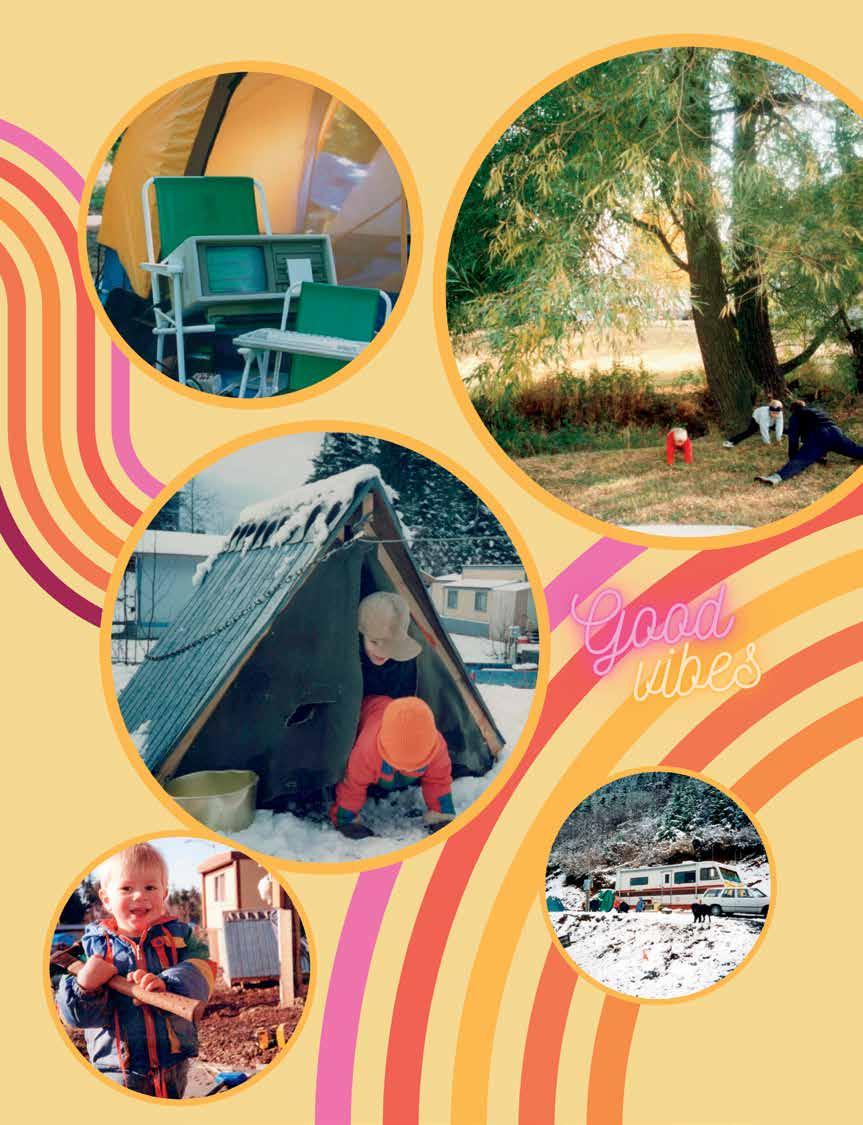
Bonus! We stayed an extra day and night. Back on the road we continued south, crossing the border into Alberta then back into British Columbia. We cruised at a relaxed pace, camping in Jasper and Banff National Parks. Max didn’t even attempt to harass the herds of elk grazing nearby and just sat guard duty beneath his picnic table. He had been tethered to the rig long enough to know he was not going anywhere without it. We re-entered the U.S. and reached our destination of Libby, Montana where my husband had accepted a temporary job while he continued to look for a permanent one. Staying for an extended time at the RV park in Libby offered the luxury of spreading out a bit. We could establish some added living space under the awning and the warm weather allowed the boys to live outdoors more than in. We took many wanders and marveled at the similarity of the wilderness around Libby to the wildness of Alaska. The boys found some playmates and I became familiar with where things were in town. The routines in our traveling lodge became so familiar and comfortable, I sometimes lost sight of the fact that this carefree lifestyle would eventually approach an expiration date.
As the summer marched on, so did the job hunting so we were able to get a phone line connected to the bus. Remember the dial-up internet days? We kept the phone in the kitchen sink. I will take this opportunity to try to describe the floor plan of our little castle. The table to eat upon had to be removed to make our bed and the kitchen sink was at the head of the bed. The boys' beds pulled from the sides to meet in the middle to make it large enough for them. Once everyone was tucked in, climbing over them was the only way to access the bathroom in the rear so you can understand the importance of following a routine to keep things easy. Each and every day a complete transformation had to take place between night use and day use. In architecture, furniture and recreational vehicles “form follows function”. This means the form must be designed around the function. Like a chair needs to be comfortable to sit on. In our nomadic situation we found the design of a motorhome led to the function of simplistic living.
Life was good and our family was happily living in the moment. I loved it . . . except for early mornings. I was frequently brought out of my sleep, face down in my slumber, by the large keyboard of the primitive microcomputer balanced on my back. Early mornings were best for typing cover letters and resumes before the boys woke up. My morning voice had to remain very quiet as my agitation directed at the perpetrator was masked with deceptively kind intonation. Again, the stars aligned and three calls came in the same day offering serious job interviews. Hallelujah. My back rejoiced at the end of being the typewriter table.
The preferred offer was from WSU in Pullman. The location would be ideal with extended family not far. We folded up the awning, loaded the dog, counted the kids and soon crossed into Washington State. We arrived in town early for the interview but he was almost late after first taking a dead end on campus requiring the car to be unhitched to allow the careful, but seldom executed back-the-bus-up-all-the-way out of a narrow one lane street lined with parked cars on both sides. The waiting period while they made their selection kept us in the motorhome for several more months. We continued traveling around to interesting sights in Washington, and Idaho, camping in parks-
-and on friends' empty lots, and then played a game of musical RV moving from Palouse to Pullman to Palouse to Pullman to comply with the seven day limits. The in-laws came from Moses Lake and rendezvoused with us in their Airstream trailer and we found out about the family history connecting them to the Palouse. My father in-law, Ed showed us a house he had lived in as a youngster in Moscow, Idaho. He remembered seeing horses tied up to hitching posts in front of the post office and also climbing all those steps to the grade school. He was even related to early residents of Palouse, who had a hardware store there, the Ancorns.
The position at Washington State University was offered and we soon stepped out of our compact home into a (what of course felt like an enormous) two story house in Garfield, Washington. We had been contained in our cocoon for nine months and had traveled more than 3,000 miles. The RV was parked next to the house while we waited for our container to be delivered by a Spokane trucking service. The bus had become a way of life for our family and it was notably emotional to put the ‘for sale’ sign in it. I wish I had taken more pictures of our journey to keep such good memories; meeting dozens of folks from different backgrounds, and discovering we all share so many things in common, the freedom of staying another day or taking to the road, sharing daily tasks and helping each other, homeschooling and using historical sites and small town libraries for opportunities to learn amazing things together, treating a lice break-out passed along from newly found playmates, having the flu while on the road and begging to park for a while to stop the rocking…well ok, those last two weren't really “good” memories but they will stay with me. We were safely delivered to this beautiful, agricultural mecca of the Inland Northwest. In place of naming the types of whales we would begin to learn all the types of farm equipment roaming and sculpting the endless sea of crops. I did not see any sign of our dog wanting to board the bus again once it was parked and the boys vowed they would never again want to sing “The wheels on the bus go round and round”. The goldfish had developed an odd Tourette-like zig-zag in his swimming pattern when his bowl became stationary. But MY glass seemed very full as a result of our adventure. Incredible as it seems, most days in the bus did not seem that crowded. I suppose we were one of those close families from the start, always wrestling, hugging and generally in each other's hula hoop anyway. In addition to learning to share toys, the boys also had to learn to share space. We were literally all in it together. Showing consideration for others' moods and privacy had to be practiced on a daily basis. Kindness and compassion were lifted from the pages of The Book of Virtues (author William J, Bennet) and practiced as a language of love. Having to choose an alternative lifestyle was an exercise in finding solutions and I think each of us were enriched from that aspect. There was room for everything we truly needed. Love doesn’t take up any space at all. When my younger sons shared with new friends that they had been born in Alaska they were asked if they had lived in an igloo. Their reply was “No, but we did live in an RV”.
Home&Harvest | Jan/Feb 2023 74
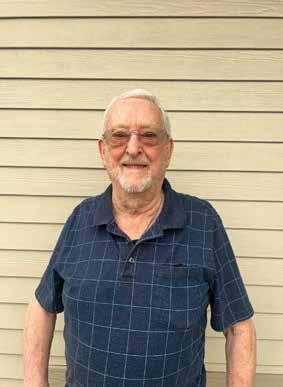












Schedule a tour today! egeral.com • 509.758.5260 Life is best lived with people who deeply care about you. At Evergreen Estates, everyone is family, and the relationships built are everlasting. – DAVE WEATHERLY EVERGREEN ESTATES RESIDENT I am happier here than I was at home. Thank goodness for Evergreen Estates. Quilt SQuilt Shop hop IS SEASON... FALL IN LOVE WITH NEW FABRIC & NEW DESIGNERS! 1500 Levick St, Moscow, ID LOCAL LOCAL W W W . R E B S F A B S T A S H . C O M PRECUTS, YARDAGE, QUILT KITS, NOTIONS, & MORE ONLINE OR IN-STORE
The Oh, Otis! Shenanigans
Episode 15
How to Ruin a Perfectly Good Game of Tag
Otis stared, mouth gaping, as he watched Carla wipe her runny nose across the sleeve of her purple winter coat. It left a shiny mark, proof of a snot deposit. He knew he’d done the same thing a million times. But he was a boy, and she was a girl, and that made it wrong. Girls should not wipe boogers on their sleeves. He shook his head in disgust as his friend, Fertis, came roaring over to him.
“Dude!” Fertis breathlessly shouted. “The Hill is slicker than snot! C’mon! Let’s go!” Fertis’s face sparkled with enthusiasm, his nose and cheeks a cheery pink, and his hair peeking out from under his knit cap. Otis didn’t respond immediately, which made Fertis take note of the look on his friend’s face. “What’s wrong? You look totally grossed out.”
“Well, speaking of snot, I AM totally grossed out,” Otis remarked. “I just saw Carla wipe her nose all over her coat.”
“Gross!” Fertis squealed. “It’s one thing when we do it, but a girl doing it? No way.”
“Way.” Otis was glad his friend agreed with him. “I stood right here and watched her.” They looked over to a group of girls nearby, scrutinizing the oblivious Carla as she talked with her friends Angela, Jodi, and Laurie. She was whispering, and suddenly all four girls turned and looked at Otis and Fertis.
“Let’s scram,” Fertis muttered and scooted off, away from the four pairs of staring eyes. Otis quickly scurried next to his friend, relieved to escape the glaring girls. The two boys started jogging toward the top of the sled hill, Fertis dragging his red toboggan behind them. The entire third-grade class was enjoying sledding and hot cocoa, guests of Fertis and his parents. For the past several years, the January doldrums were whisked away for a Saturday when Mr. and Mrs. Smenk invited Fertis’s entire class to go sledding, play in the snow, and enjoy homemade hot chocolate and goodies. Thirty-four third graders swished and swooped down the bowl-shaped field behind the Smenk barn. A few parents were mulling around with Fertis’s parents to chaperone. For the most part, however, the kids ran around in the snow with minimal supervision.
Fertis and Otis joined their good buddy, Clark, at the top of the hill and surveyed the situation. There were three possible treks from their vantage point. One would take them down a meandering slope toward the barn. Fun, but not thrilling. The second route would scoot them down the steepest center part of the bowl, which provided a heart-in-your-stomach ride, but most kids littered that part of the hill, making it challenging to avoid sleigh-on-sleigh crashes. The third option was on the backside of the bowl. Over the past several days, the wind and snow storms had formed an enormous drift. If one chose that path, they would glide about a fourth of the way down and then launch off the end of the drift into the air with unknown landing consequences. It could go easy; it could go rough. Either way, you’d have an exhilarating trip to the bottom of the steep hill. Out of the three, the backside course was the most electrifying. But it also was the one that involved the most walking back to the barnyard. The three friends pondered as they watched their classmates zoom down the sparkly white slopes. Not many chose to sail off the backside drift, and at that moment, no one was anywhere near the somewhat hazardous stint, so the three boys opted for that to be their next run.
by Temple Kinyon
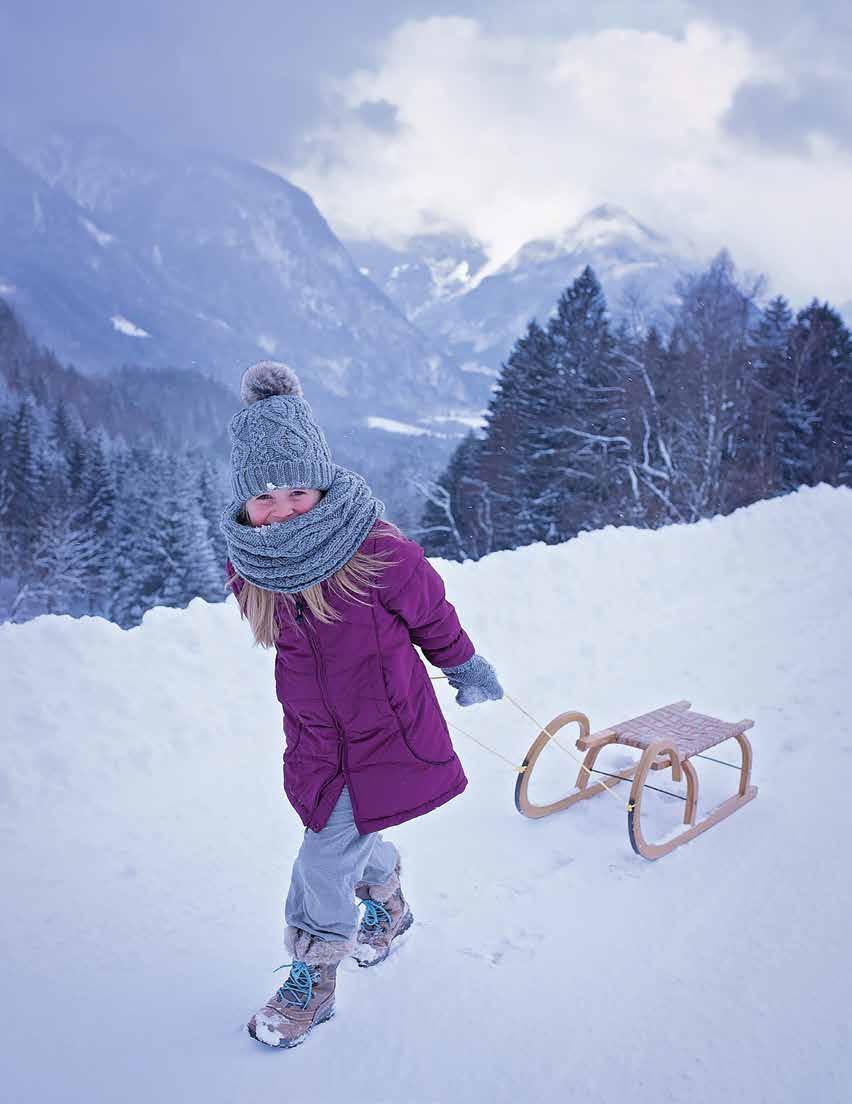
Fertis’s toboggan was long enough to fit three thrill seekers. A required quick game of rock, paper, scissors to determine seating order ensued. There were pros and cons to each position. Front had the best view but zero protection. Middle had the padding of the pals in front and back, which was good and bad. The back spot got you enough visibility to know when to bail and the easiest escape route off the sled, but the end rider flailed about more than the other two when hitting the bumps.
“Ok, guys, rock, paper, scissors. One, two, three, GO,” Fertis instructed.
The three smacked their closed fists into the palm of their hands three times and whipped out their fingers in the form of their chosen weapon. Otis picked paper; Fertis and Clark picked rock.
“Paper covers rock. Otis, you win. Where do you want to sit?” Clark asked.
“Front,” Otis stated.
“Ok, front it is,” Clark remarked. He and Fertis did another quick round. Clark won and chose to sit in the back.
“Awww, guys!” Fertis moaned. “I hate being in the middle.”
“We’ll go three times and take turns,” Otis stated.
“Ok, that’s fair,” Fertis said and smiled. Otis was always about being fair.

They loaded onto the toboggan, careful not to let the slick plastic separating their butts from the hard, packed snow slip away down the hill. There was nothing worse than losing your sled to the bottom of the hill as you stood at the top, watching it go without you.

Clark’s snow-booted feet piled onto Fertis’s lap, and Fertis piled his booted feet onto Otis’s lap, interlocking the three on the sled.
Otis kept one of his feet out as the brake while he curled the other behind the front of the sled. “Ready?” he asked.
“Roger,” Fertis answered.

“Clear for take off, Captain Swan,” Clark giggled.
“Here. We. Go!” Otis yelled, lifted his brake foot, and tucked it behind the front of the sled as Clark pushed off from behind with his hands.
The toboggan started down the slope, the weight of the three funsters making take off a bit slow. But in a matter of a few seconds, the red sled rocket gained speed. As they coasted swiftly down the incline, Otis watched as the edge of the massive drift came closer and closer. “Hang on!” he yelped just as the menagerie hit the drift and hurtled into the air. Otis always marveled that whenever his shenanigans took him airborne, it seemed like his life clicked into slow motion. He looked out into the vast blue sky, took in the beauty of the sparkling splendor of the snow-covered fields and hills, felt the cool kiss of the winter breeze on his cheeks, and breathed in the frigid air, causing his nostrils to momentarily freeze shut. The silence was glorious. Then he looked down.
The snowy ground was coming up fast.
He instinctually hollered, “Brace for the landing!” since he had the best view of what was about to come, and he was, after all, captain of the ship. He felt Fertis’s grip tighten around his waist.
KERRRRWHUMP!
The sled landed hard, spraying a wave of snow as it barreled down the hill. Otis held fast to the handle on the toboggan but steering the plastic beast was an insurmountable task.
The speed, combined with the icy conditions, proved too much. The toboggan started to careen sideways. Seeing no course correction from Otis, Clark bailed, using the “tuck and roll” method Otis had taught him during a recent hooky bobbing session. He came to a stop on his belly and watched as Fertis and Otis rocketed down the slope backward. He started laughing and waved. Fertis’s hand shot out in a quick wave, but Otis held tight to the front of the toboggan, his expression conveying sheer terror to his friend. Otis leaned to the left, and the sled began to turn back to face forward. Clark thought it looked like they were out of the woods until they hit a dirt clod hidden under the blanket of snow. The sled pitched into the air at a steep clip and hurled back down to the ground, crashing into a spectacular mass of snow and dislodging Otis and Fertis into a mix of toboggan, legs, and arms. The two lay motionless for a quick beat, lumps of coat and boots in the snow. Slowly, they began moving and moaning. Clark quickly jumped up and started down the hill to assess the damage. Suddenly, another sled flew past Clark on his right, nearly hitting him. It was Carla and Angela! Then another one swooshed past him on his left. Jodi and Laurie! Quicker than he could comprehend, he watched as Laurie bailed off the back of the sled, leaving Jodi solo, screaming down the slope toward Otis and Fertis.

Laurie hoisted herself up, and an evil smile grew over her face. She stood about 10 feet away from Clark, but he heard every word she said. “We decided it was time to play a game of tag,” she smirked. “Kiss. Tag.”

Clark froze, then, as Laurie jumped into a full run, he dodged her and ran down the hill as fast as he could, trying hard not to take a header into the snow. “YOU GUYS!” he yelled at his two crashed comrades. “THEY’RE PLAYING KISS TAG! RUN!”
Otis was still seeing stars as he sat facing the whole scene. He witnessed the girls come whizzing down the hill and heard Clark’s warning shouts, but connecting the dots in his addled brain took him a moment. Carla and Angela’s sled headed straight for him. He managed to snap back to clarity and roll out of the way just as they whisked past him. But he knew he only had seconds to get some distance from them. He strategized that they wouldn’t want to run up a hill because who would want to run up it, so maybe he could save himself. He managed to waller himself up in the cumbersome snow and began scooting up the hill.
Fertis, on the other hand, moved too slowly. Just as he’d pulled himself out of the crash-induced daze and got on his feet, Jodi roared into him with her toboggan, flattening him on his back as she scooted over the top of him. She jumped off the sled and landed on his chest.
“Don’t you dare!” Fertis screamed. “Do NOT kiss me!”
“Too late,” Jodi quipped and landed her lips in a big, wet, lip-on-lip smacker with the unwilling, wriggling Fertis. She finished off the dastardly deed with a wicked laugh. Meanwhile, Carla and Angela were gaining on Otis. He could outrun them any day at school during recess or gym, but today he was no match for the kissing tag fiends. He heard them coming and tried to dodge to the right, but in doing so, Carla ran right into his back. Down he went, face first into the crunchy, cold tundra with Carla clinging to his back. For a moment, he couldn’t breathe, which made him panic. He wriggled enough to catch his breath and knock Carla off-
at the same time. He started to scramble up the hill, but she grabbed his snow boot and stopped his progress.
“Otis Swan,” she proclaimed, “I’m going to kiss you whether you like it or not.”
“Don’t you dare!” Otis roared. “You have snot! You’re sick! I don’t want your germs!” Otis swore the laugh that came out of her mouth rivaled the hysterical cackles of Maleficent in the Sleeping Beauty movie he’d seen on Wonderful World of Disney. A chill ran up and down his spine, but it wasn’t because he was cold. He twisted out of his boot and jumped up, running with one booted foot, and one socked foot as fast as he could. He hadn’t been paying attention, however. He didn’t see Angela as she blindsided him. The tackle was beautifully executed. She slammed into him so hard his feet flew up, and he landed with a thud on his back, the wind knocked out of him.
Angela promptly plopped onto his chest and held his arms down. Otis gulped in air and tried to squirm away. “Oh, no you don’t,” Angela laughed. “You’re not getting away that easy.”
Carla ran full speed to Otis. She dangled his boot by its laces above his head. “I’ll give you your boot for a smooch.”
Her sing-songy voice sent Otis into a full-on struggle to get Angela off his chest, but she seemed to have superhuman strength. He was stuck.
“No deal!” Otis’s last attempt at avoiding a kiss wasn’t a wellthought-out plan.
“Ok, I see we’re going to have to do it the hard way,” Carla laughed with another spine-tingling cackle. “I’ll just kiss you and keep your boot.”
“Aww, now, Carla!” Otis begged. “Please just give me my boot, and we can go have some hot cocoa together. I’ll even hold your hand. Just don’t kiss me! I don’t want your germs! I saw you wipe your boogers on your coat!”
About that time, Clark streaked past Otis, Carla, and Angela, with Laurie hot on his heels. Otis thought his friend was going to outrun her for a second. But like a spider monkey, she launched into the air, landed on his back, and the duo went down like a sack of potatoes. Clark sank into the snow, face first. Laurie immediately grabbed the back of his coat and forcefully rolled him over. She went in hot toward his face. SMACK! A big wet one right on his lips.
Otis groaned. “Carla, please,” he calmed his voice and made his sweet request. “Just give me the boot, and we’ll call it even.”
“Otis, you seem to think you have some sort of power or options here,” Carla giggled. “You don’t. I win. I have the boot, and Angela won’t let you go until I kiss you. Pucker up, buttercup!”
“AAAUUUUGGHHHHH!” Otis wiggled and squirmed and rolled his head from side to side. Maybe she couldn’t hit a moving target.
Alas, Captain Swan was beaten. Carla flopped down next to his head and landed a wet, juicy SMOOCH right on his lips. She stood and said, “Angela, you should give him one, too.”
“Nooooooooo!” Otis tried to avoid a second round of germ swapping, but again, he was no match for a girl playing kiss tag. She landed one square on his lips, then immediately stood, towering over Otis. She offered him a hand, and he glared at her.
“Are you kidding?!” he huffed.
Angela laughed and him. “Nope. We beat you, but we’re not snooty winners. I’ll help you up.”
Otis hated to do it, but he begrudgingly took her hand, and she helped hoist him to his feet. “C’mon, Carla,” she smiled. “Give Otis his boot. You got what you wanted.” She leaned in close and looked into Otis’s eyes. “And so did I.”
Carla handed Otis his boot. He angrily snatched it away from her, popped his frozen foot into it, and started lacing it up. “You girls are crazy,” he grumped. “Kissing is so gross. I do NOT get why you have to ruin a perfectly good game of tag with kissing!”
Fertis and Clark, along with Laurie and Jodi, all trudged up to Otis, Carla, and Angela. Fertis and Clark wore cross expressions, but the girls beamed.
“C’mon, fellas,” Clark mumbled. “Let’s go wash all the girl germs off our faces and get some hot chocolate.”
“We’ll go with you,” Angela piped up.
“NO!” the three boys yelled in unison.
The girls erupted in big belly laughs and walked up the hill.
“How did we get beat by those stupid girls,” Fertis lamented. “It was like a well-executed military ambush,” Clark breathed in wonderment.
“We’ll never hear the end of it at school,” Otis groaned.
Sure enough, on Monday morning at school, the entire third grade teased Otis, Fertis, and Clark relentlessly about being beaten up and smooched by girls. Considering no one else saw the raucous game of kiss tag on the far side of the sledding hill, everyone knew every detail thanks to Carla, Angela, Laurie, and Jodi telling their side of the story.
On Tuesday morning at the Swan house, Otis scuffed into the kitchen and his siblings’ morning breakfast fracas. When his brothers and sisters took notice of his disheveled appearance, all conversation stopped. “Momb, I don’t feel good ad all,” he whimpered.
“What the heck happened to you, Otis?” Doris exclaimed.
“Yeah, Otis, you look like chicken poo,” Deanie teased but with a tinge of sympathy.
“Kiss tag,” Otis grouched. “Stubid girls and their stubid kiss tag. That’s what habbened.”
The siblings’ collective whistles, shouts, and teasing made Otis even grumpier. “I didn’t want to play kiss tag. They surrounded me, Fertis, and Clark. We had no chance.”
The squeals and peals of laughter filled the air as Otis’s siblings cleared their dishes and headed out for school. The humiliation was almost unbearable for Otis, and he knew they’d start in again when they got home after school. Thankfully this morning, they rushed out the door with only a few jabs about girls out-maneuvering him and his friends.
“Momb, I’mb so plugged ub, I can’t even breatheuh,” he croaked. “And I’mb hot and cold ad the sameb timeb, and my throad hurts. Even my hair hurtsuh.”
Mavis walked over and placed her lips gently on his forehead. “You’re running about 100 degrees, I’d guess. My poor baby. Beat by girls and then sick from their germs.”
“Momb,” Otis looked her right in the eyes. “I’mb never, ever, ever, even on a double-dog-dare going to let a girl kizz me ever againuh.”
“Oh, Otis,” Mavis smiled. “I’ll remember you said that. And I’ll be sure to remind you of your words when that’s all you’re going to want to do is kiss girls.”
“That’ll never habben, Momb,” Otis stated. And his nine-yearold self meant it.
***



MANAGEMENT CLASSES BY RURAL RESOURCES ALSO AVAILABLE: Caregiver Support groups In-home care programs Kinship Caregiver program State program application assistance Grief support group CONTACT: 509-332-0365 KNOPENS@ RURALRESOUR CES.ORG NEED A CAREGIVER? WANT TO APPLY FOR MEDICAID? RAISING YOUR GRANDCHILDREN? CURIOUS ABOUT SUPPORT GROUPS?
FREE CHRONIC DISEASE SELF-
Photo credit: braininjurysvcs.org
SMART
that makes their banking low maintenance with Idaho Central. We provide their family (and yours) with the banking solutions that fit the way you live. Why bank harder when you can bank smarter?
• Apply for a loan and much more with Video Chat


• 24/7 access with Mobile and Online Banking
• Check your credit score with My Credit
• Earn unlimited rewards for everyday Visa purchases
• Manage your cards with CardControl
• Send and receive money with Zelle® Join the family at: iccu.com/thegreens
Tri-State
Joint Orthopedics Program
A Collaboration Between
SURGERY CENTER
Through the use of Mako SmartRobotics, the Tri-State Joint Orthopedics Program is improving the surgical experience for all of their patients. By utilizing advanced 3D modeling and a guided robotic arm, the surgical team provides a more accurate level of precision so that you can begin to heal today, and thrive tomorrow.

Regan Hansen, MD
TOTAL JOINT RECONSTRUCTION Lewiston Orthopedics


Bryan Beardsley, MD SHOULDER, KNEE, HIP Lewiston Orthopedics

DeWayne Weaver, MD SHOULDER, KNEE, TENDON Lewiston Orthopedics
























 by Annie Gebel
by Annie Gebel



















































 By Trent Morgan
By Trent Morgan






















































